Croatia has been on our medium-term, must-travel list for some time. And finally, for Aron’s first vacation from being a Urology resident, he and I booked a trip to Dubrovnik. Everything worked out perfectly—well, worked out that eventually we would fly seven different legs on six different airlines! That, however, is the price one has to pay for a last-minute miles ticket.
Our vacation actually started in New York City: as we didn’t have to leave for the airport until the late afternoon, we got to enjoy a leisurely weekday brunch. Our first leg was an easy transatlantic Scandanavian Airlines flight to Stockholm, where the airport was like an upgraded Ikea showroom—only here, instead of pressed wood furniture and cheap hot dogs, there were duty-free bottles of perfume, elk sausages, and reindeer pelts for sale.
Our next flight, on Austrian air, took us to Vienna, from where we would only have 35 minutes to make our next connection. Thankfully, we had asked the agents in Stockholm to alert the next airline of our tight connection as there was someone to meet us on the runway in Vienna. He brought us directly to passport control, and then up a flight of stairs on a short-cut to the gangway, allowing us to catch our flight to Dubrovnik despite landing 20 minutes late. Getting on the plane, it felt as if a minor miracle had occurred. I took the window seat and was able to add to my collection of aerial photos as we flew into Croatia and over the new and old parts of the city.


DUBROVNIK
The Dubrovnik airport is wonderfully small, and having packed only carry-on (in anticipation of our tight connection) we were quick to leave for the town immediately. We had to cool our heels though, and wait for the rest of the passengers to get their luggage—as the single bus only leaves from the airport after a flight.
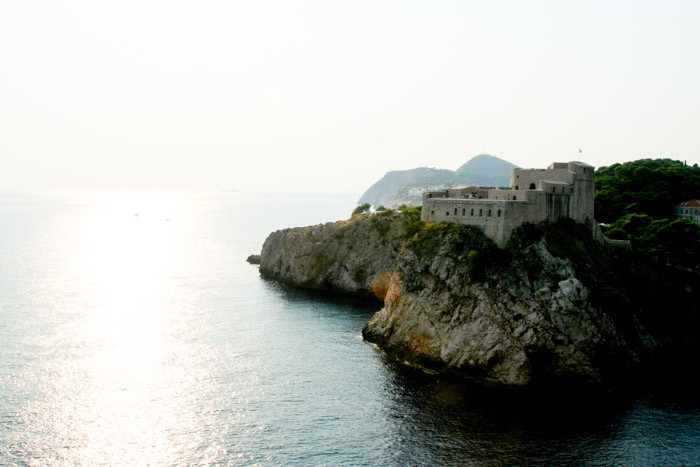
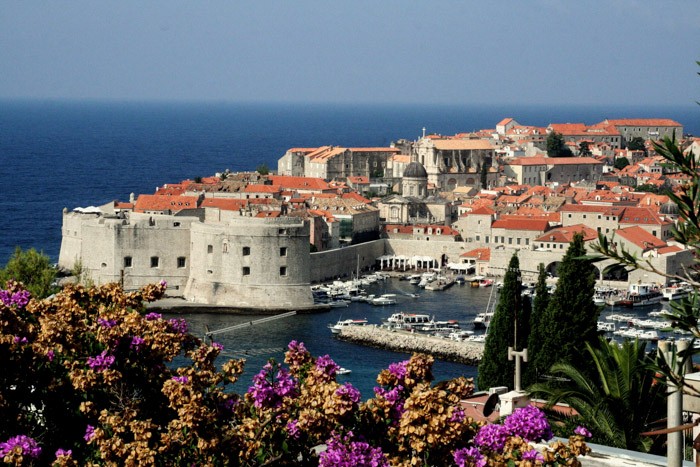
Driving up the coast from the airport to Dubrovnik, the scenery reminded us of that of coastal Italy: shear rocky cliffs and hills abutting wonderfully azure and turquoise water.
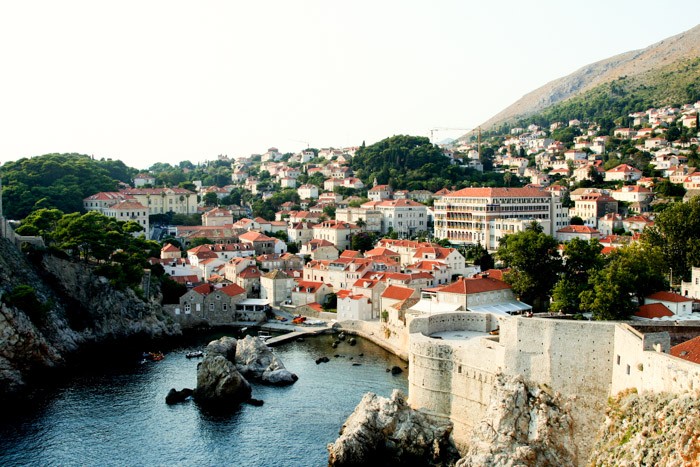
We arrived on the skirts of the old town and walked with our packs up to the Hilton Imperial Hotel, where Aron’s parents had generously given us four nights. The hotel opened in 2005 after a major restoration; formally the 1897 Grand Hotel Imperial, the building was partially destroyed and had fallen into disrepair after the war.
It is just a three minute walk from the Pile gate, the main gate into the old city, making it the perfect base camp for us. We passed on the first room they showed us, but the second room was excellent with a view up the hill and down to the front of the hotel.
The room was lovely, but we didn’t linger long; after a brief interval, we went back to the Pile gate, entering the city in the lovely late evening light. We decided to get a lay of the land by walking the city walls. The walls are more than a mile long, stand up to 100 feet tall, and were built during the 13th and 16th centuries. This description doesn’t do justice to the amazing feeling of looking over one side and seeing the city’s red terra-cotta roof tiles, its polished limestone and marble, and looking over the other side and seeing the penetratingly blue and clear Adriatic sea.
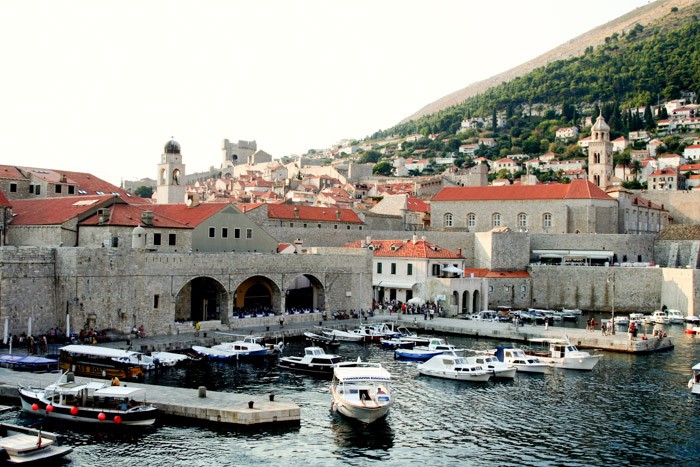
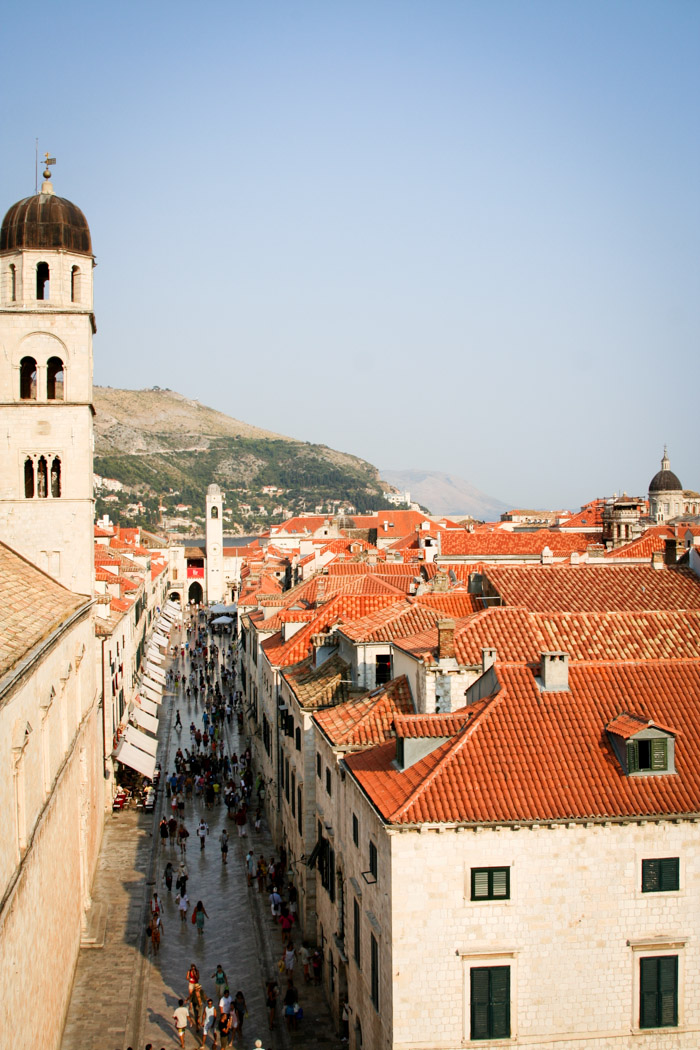
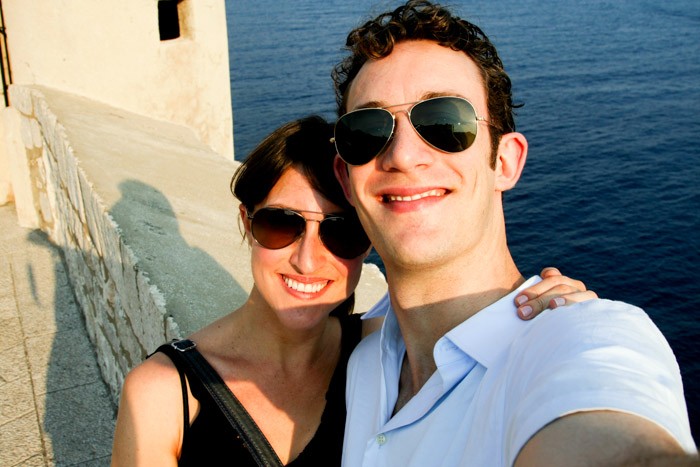
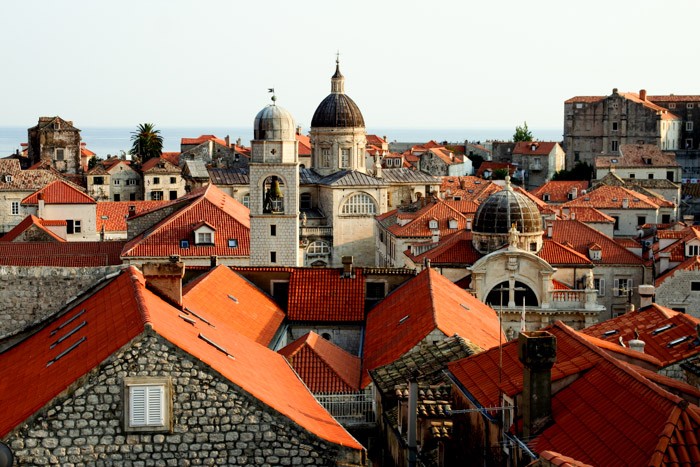
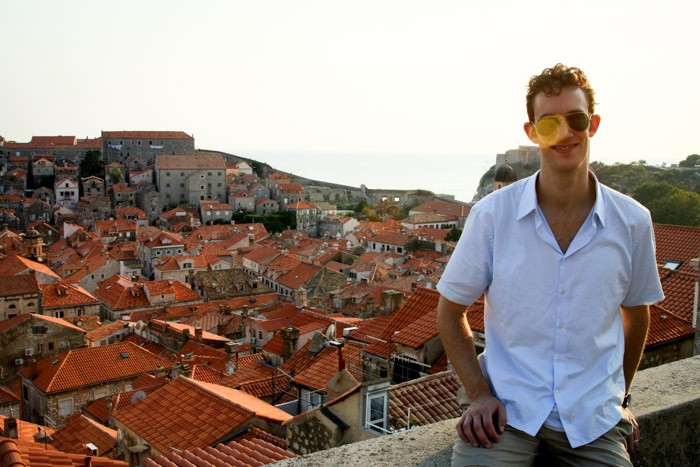
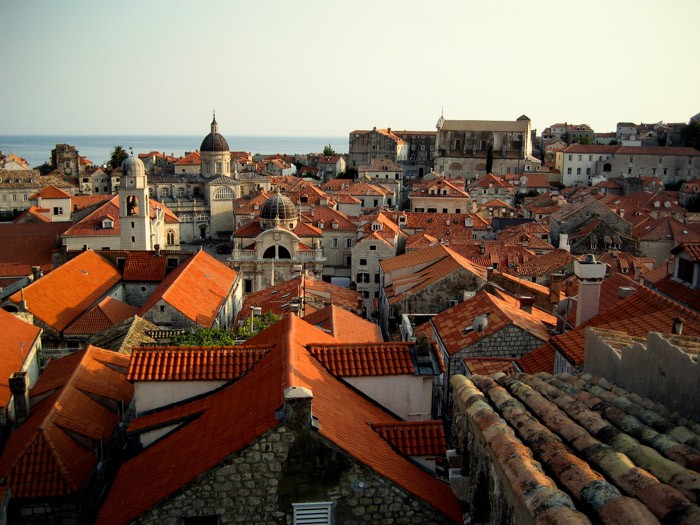
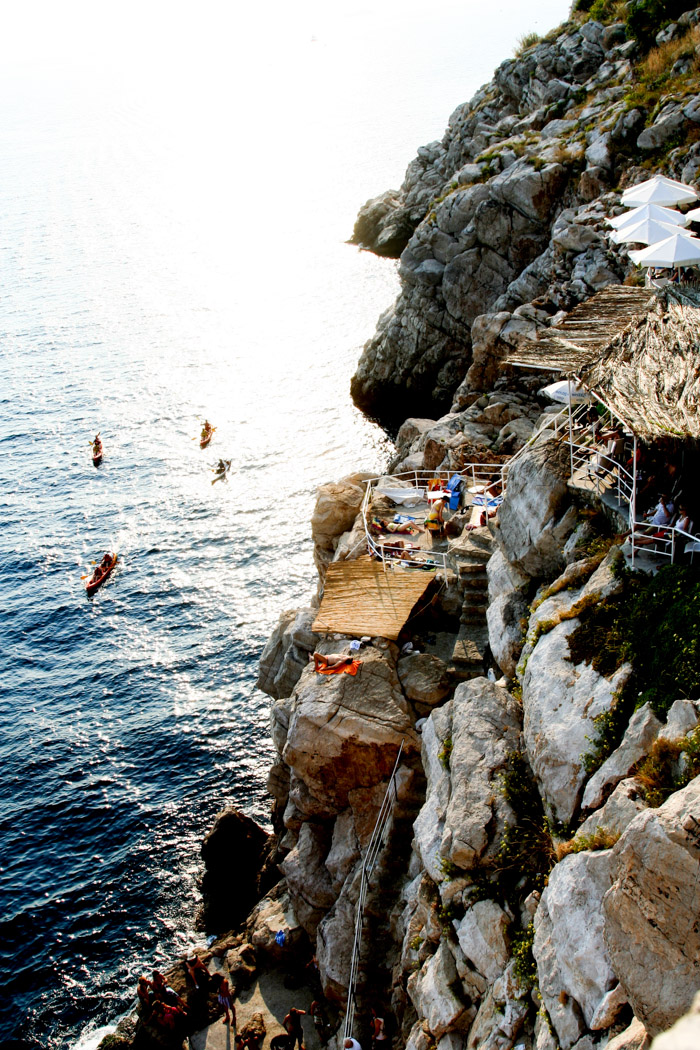
We walked the full circle, climbing past the church and admiring the fortresses built into and next to the walls. We lingered atop the fortifications at closing time (6 p.m.) to watch the reflection of the setting sun against the stones, polished to a sheen by centuries of wear.
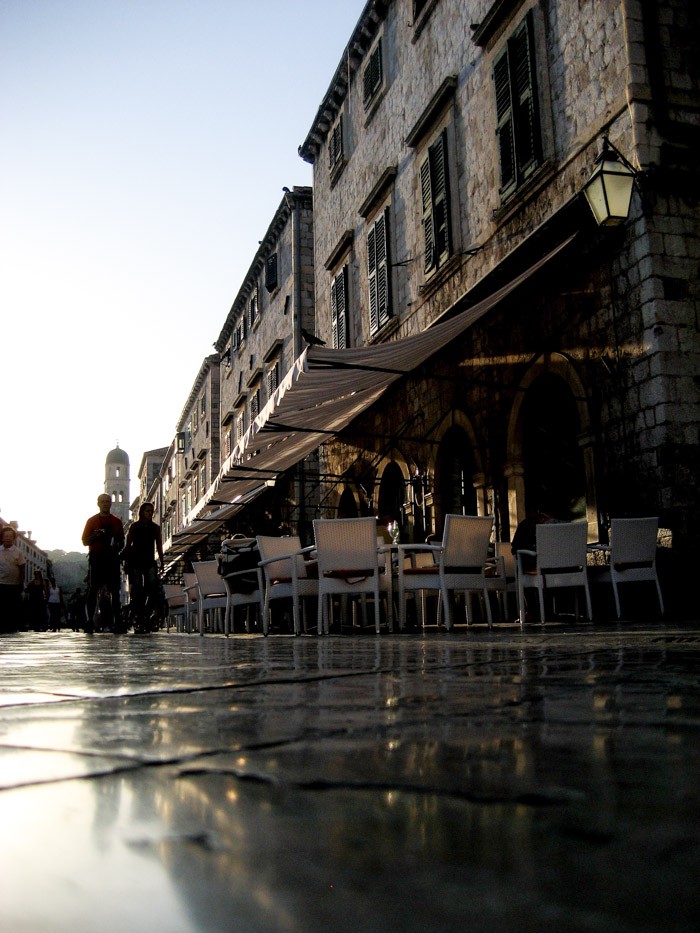
And then climbed down, directly into the fray of the main street below—the Stradum or Placa, which is lined by charming buildings of a style reminiscent of those in Venice. Apparently, there even used to be a canal that ran down the (now) middle of the city, adjacent to the main road that divided the Romans from the Slavs. Eventually, the two cities merged and the canal was filled in.
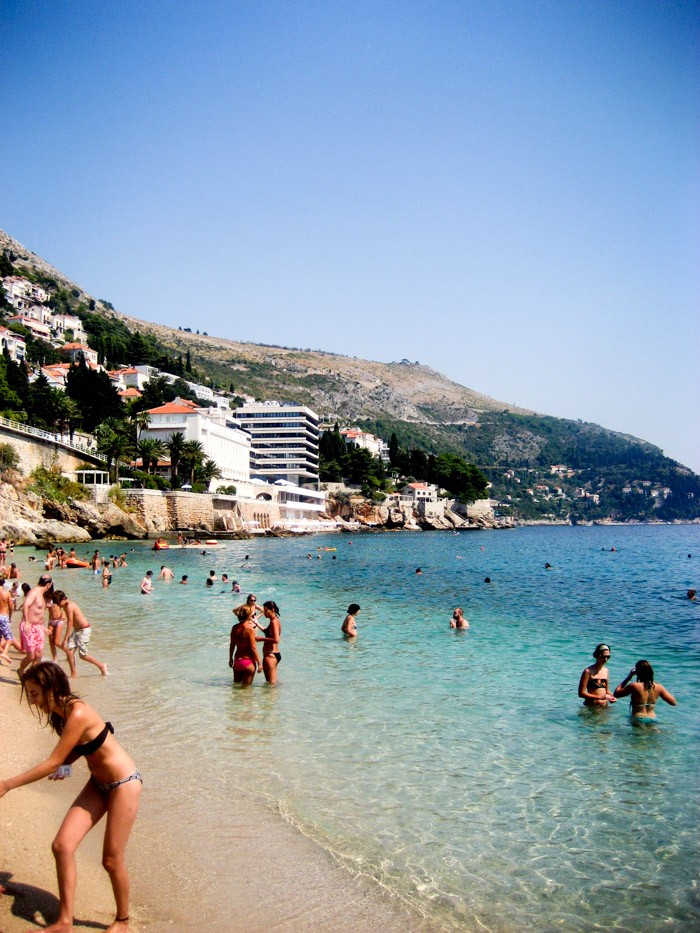
The following morning, after a very pricey but vast buffet breakfast at the Hilton, we knew we would need to force ourselves to slow down in order to truly transition into vacation-mode. So we donned our swimming suits and we headed to the beach.
The nearest beach, Banje, is on the other side of the old city, by the Ploce gate, a short 10 or 15 minute walk away. The beach is made up of pebbles and small stones, which made it all the easier for us to justify renting two beach chairs and an umbrella for the day. Though we both used to be sun-worshipers, knowing the damage sun does to one’s skin makes it impossible for us to enjoy sitting on a beach for long without the cover of shade—so the option for an umbrella was really appreciated, and we spent the day lounging and enjoying the sights and sounds surrounding us.
Banje, which is also sometimes called East-West Club (the bar/restaurant that rents chaises), has a lovely view of the small island across the way (Lokrum) and of the old city. Once settled into our location, we were ready for a swim.
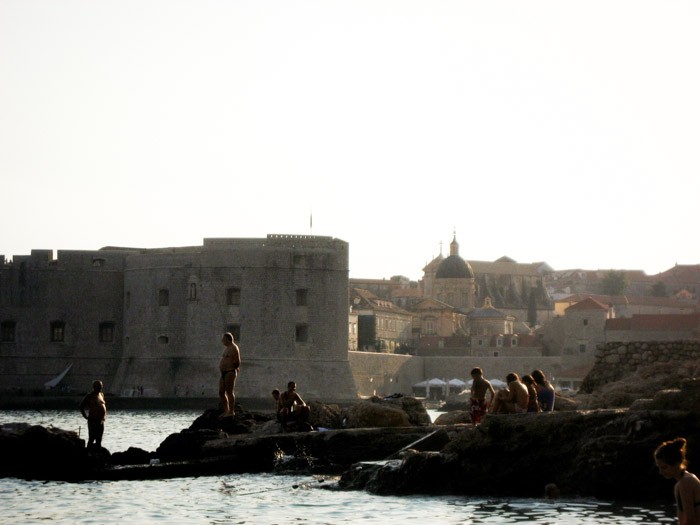
Although perfectly clear, the water was not as warm aswe expected. Whoah, Nelly!
But after inching our way in up to our waists (you know, doing exactly what you shouldn’t do when getting into cool water), we finally took the plunge. Of course, once in, the water felt lovely and we adjusted rather quickly. We brought our masks and snorkels and though there were mainly grasses, we were glad we had the means to really appreciate the clarity of the water. In fact, throughout our trip we found ourselves remarking on how clear the water is. Even in busy ports, one can look down from a dock and see the bottom—30 or so feet below—without difficulty.
On our way back through town, we came upon this little ledge on one of the church’s walls—apparently men could prove their masculinity by balancing on the ledge while facing the wall, during which time they would remove their shirts. (Perhaps Aron should decide whether or not to disclose how he fared.)
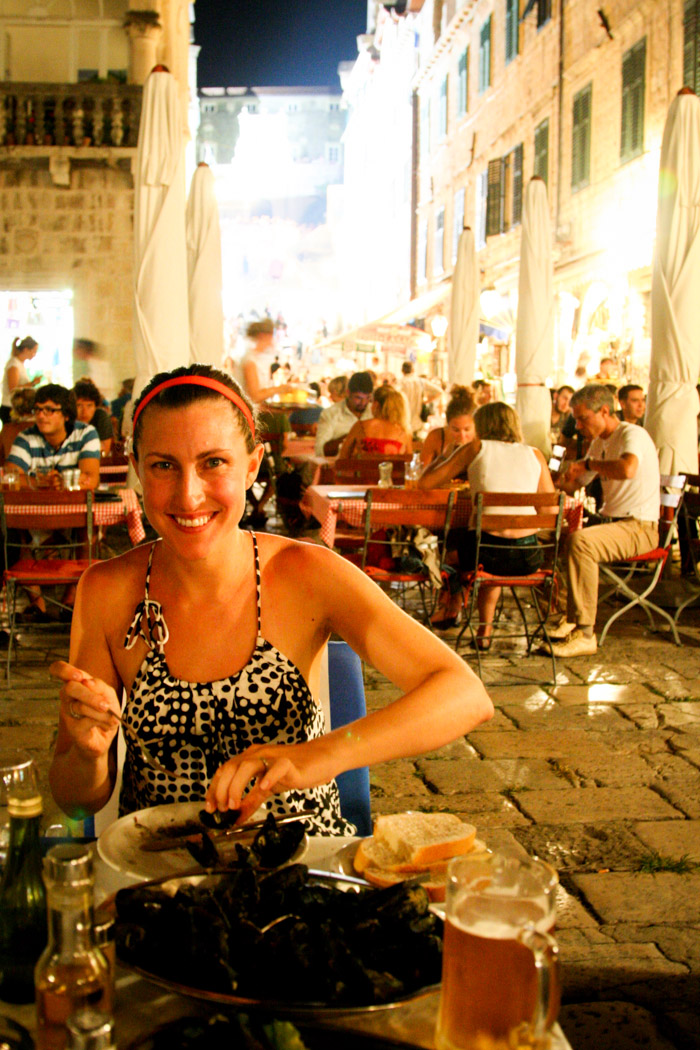
After a short break at the hotel, we were back inside the walls (another stop at the ledge) and en route to Konoba Kamenice, a reported favorite with the locals for fresh seafood. We joined a crowd—of people and stray cats—for a spot of the plaza. The wait was entertaining. It appeared that the owners were accepting some line-jumpers from time to time, and the little Italian woman behind us was outraged! She looked, incredulously, at Aron and asked why he wasn’t doing anything about this. And eventually, while shifting to get looks around us at the plaza, she demanded that we say something. “Those people are taking your table!” We, however, were determined not to make a scene or do anything to risk making ourselves appear as “ugly” Americans, so we smiled at her. We probably looked a little silly, really—so much smiling. Finally, she stomped across the plaza to confront the man in charge, presumably the owner. She returned to explain that—and she pointed—“that table, and that table, and that table… all family!” And with a shrug, she stopped shifting about. I was a bit relieved when we could move away to our table.
Rumor hadn’t failed us—the food was delicious. Aron thought that the squid risotto (black with ink) was a bit too much like a paella, but we both agreed that the flavor was wonderful. I thought the mussels were great, although throughout the trip I struggled a bit with the barnacles and sea grasses that tended to accompany the shells. I’ve become accustomed to clean, shiny black bivalves—these were very different.
Perhaps the best bit was just the fact that we were sitting in such a beautiful plaza on such a lovely night.
ELAFITI ISLANDS
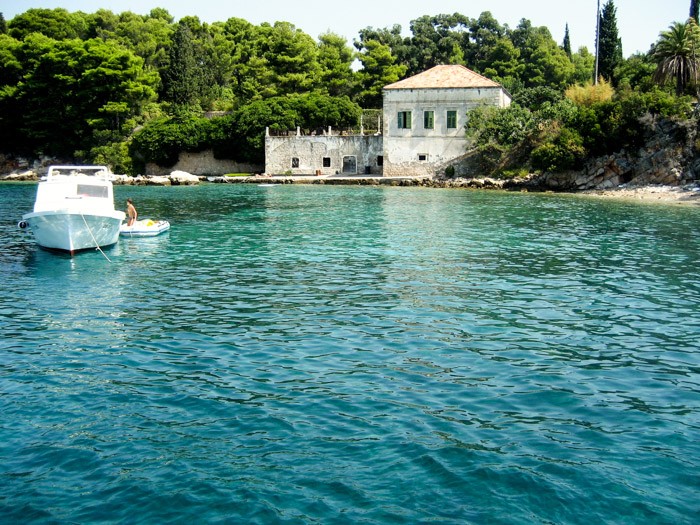
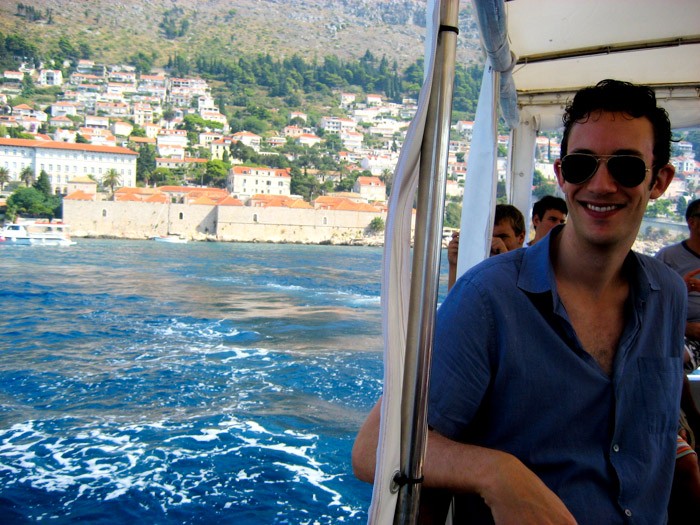
After dinner we found some gelato and wandered out to the harbor to book a boat trip for the next day. No sailboats on offer in our budget, but we did get tickets for a three island tour. Kolocep, Lopud, and Sipan are the Elafiti islands—all very small. Perhaps because all but us knew that we’d chosen the slowest boat possible, we had the vessel nearly to ourselves. We declined the lunch option—available for a small additional fee—and instead sought out lunch at our first stop.
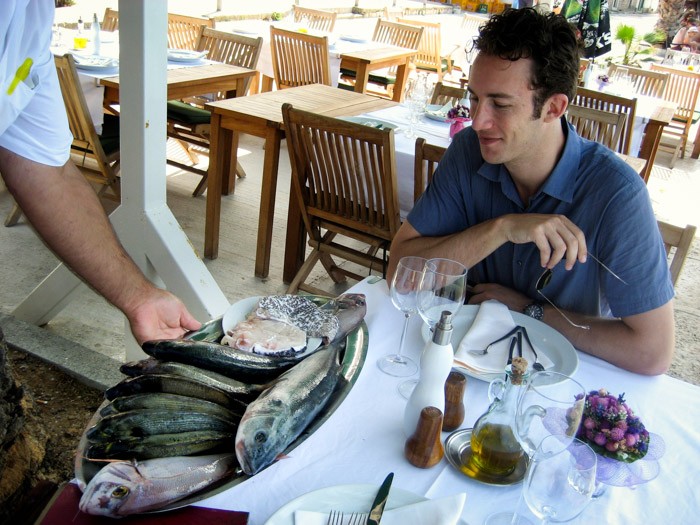
We found the most beautiful little restaurant overlooking the small bay in Kolocep, with teak tables and chairs and white tablecloths. Aron asked about the fish specials, and the waiter brought out a tray of the freshly caught fish for his selection. I couldn’t pass up the truffle and mushroom risotto, though the waiter shook his head when I didn’t choose seafood. We shared a plate of local cheese and honey, as well as a bottle of white wine.
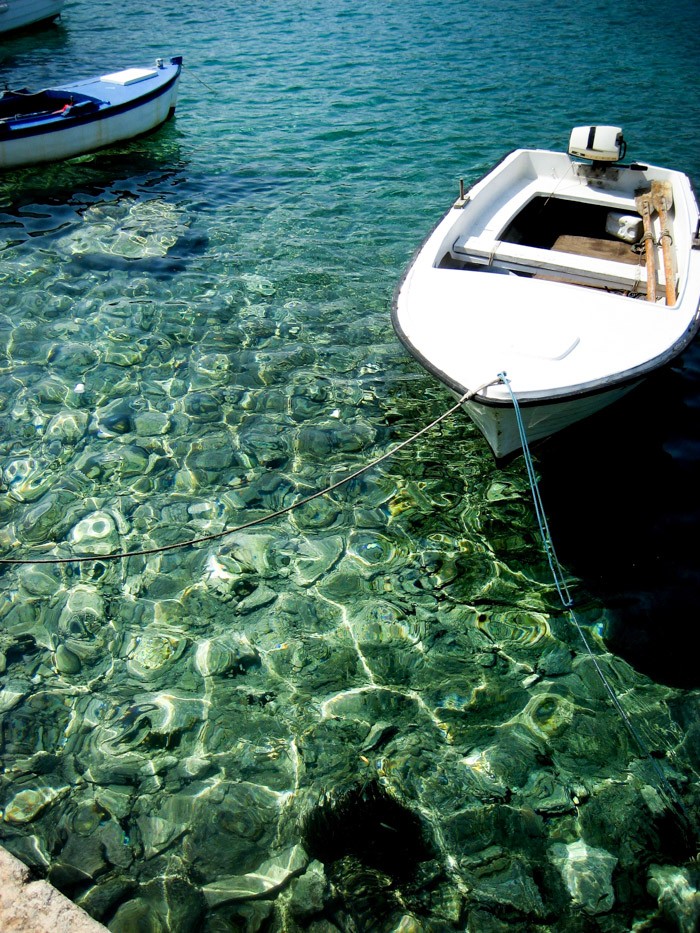
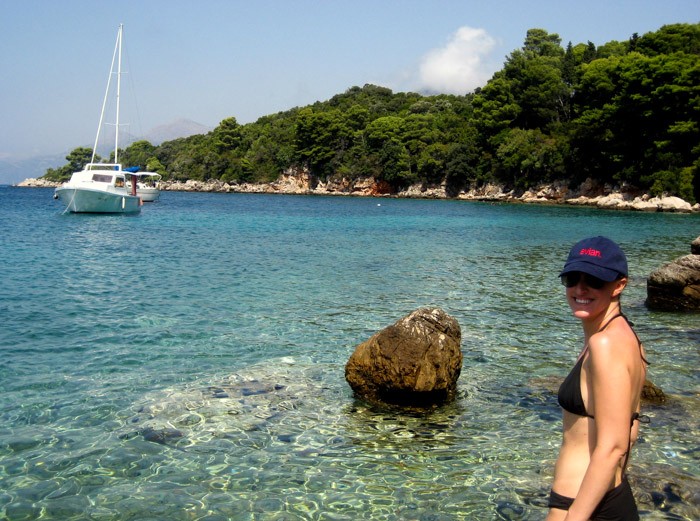

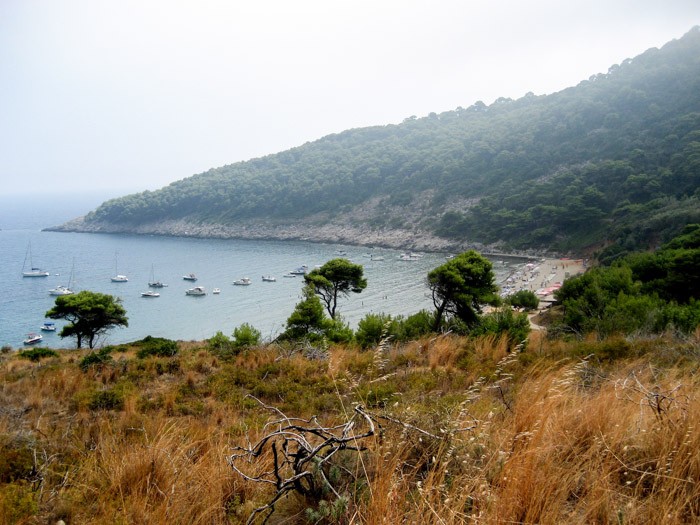
We had forgotten to bring any towels, so we bought some very thin and very colorful towels at one of the convenience stores before a taking a quick dip and then returning to our little put-put boat. From there we continued on to Lopud.
Lopud is discussed in many books for its sandy beach (Sunj Bay, above), reachable with a 15 minute walk across the island. Most beaches in Croatia are rocky. However, if you’re fine with renting a beach chair—and this is what we did throughout our trip—the rocks can actually be really nice. You leave the beach without all that sand in your suit, your books, your snacks… Still, we had to check this one out. The walk through the hills was a nice change from the beach scene, but once we got to the other side, we found we were in the shade. So we took in the view, and returned to the sunny side of the island.
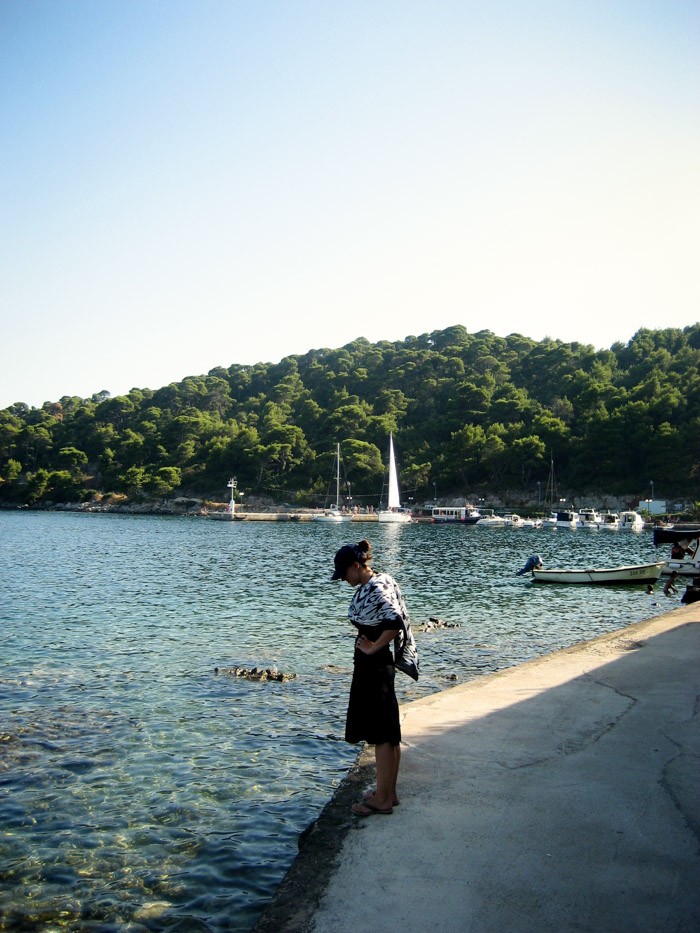
Our third stop, Sipan, is the largest and most populous of the three islands, but to be honest—and I know it’s hard to complain about seeing such lovely places—we felt like we might have preferred to stop after two or even after one island. It’s not that the islands are at all the same, but they’re not sight-seeing destinations. What’s so special about them is their pace and their size, and that uniqueness could really be appreciated with less stops. We had only 30 or so minutes at Sipan, so we took a look around the little harbor before boarding again for a slow ride home.
Aron and I enjoyed seeing the islands, but I’m not sure I would recommend booking one of the three-island-tours out of Dubrovnik’s harbor. Should we have the chance again, we’ll seek out a boat that is more of a destination in and of itself (a sailboat would be ideal), and a singular destination upon which you can just stop and spend the entire day. “Hitting” all three is probably overkill. I’d recommend exploring one’s options before arriving in Dubrovnik.
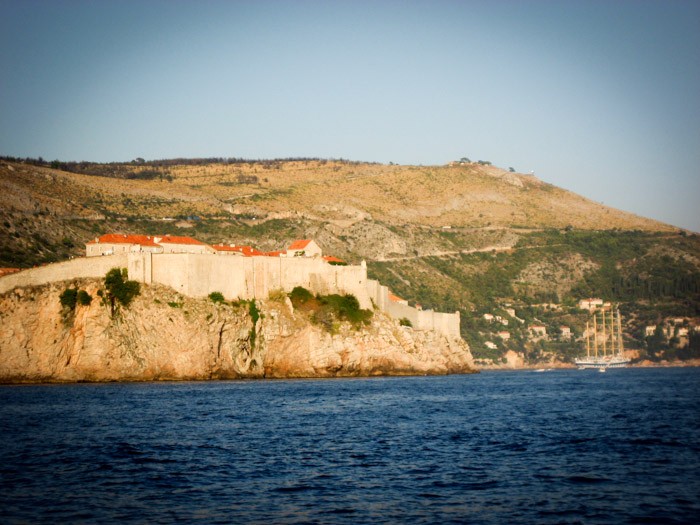
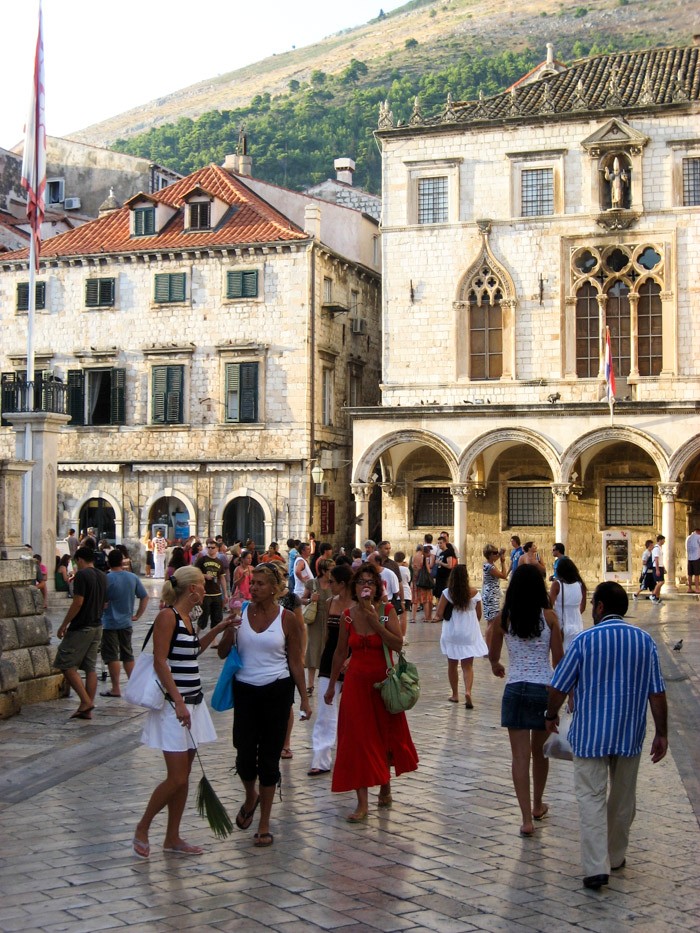
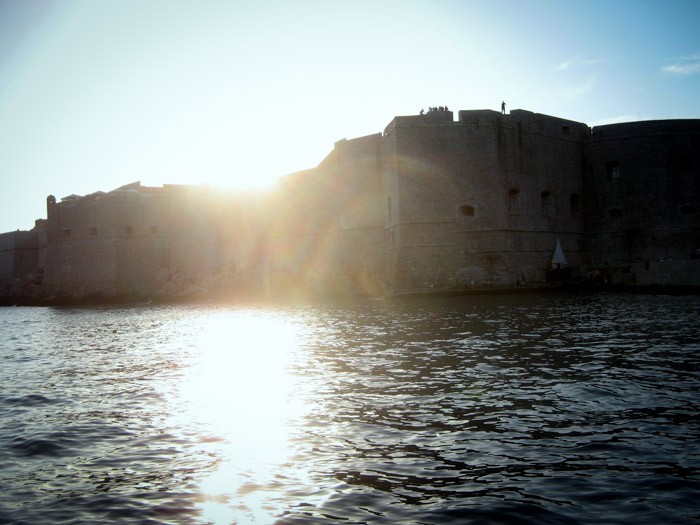
The afternoon glow in Dubrovnik is especially striking. The stone seems to take on tones of gold and pink. Everything just beams. The stones have a sheen such that the sunset is reflected almost as if on a lake. We really loved the walk down the stradum and back to our hotel each day. The afternoons are also nicer as most of the crowds have either returned to their rooms or to their cruise cabins.
We actually never spent any mid-day hours in town, but each morning—as we made our way to the beach or to the harbor or to wherever it was we were headed—we definitely noticed those notoriously crushing August crowds. So we really appreciated our afternoons.
And after a walk through town, we went to the bar at the Hilton and shared a bottle of champagne before dinner.
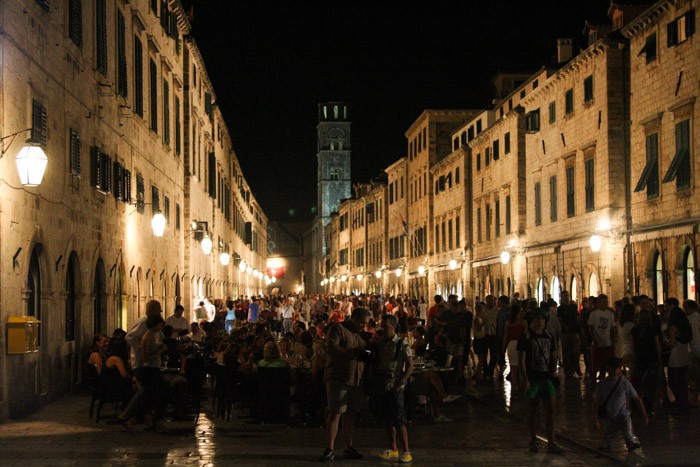
MONTENEGRO
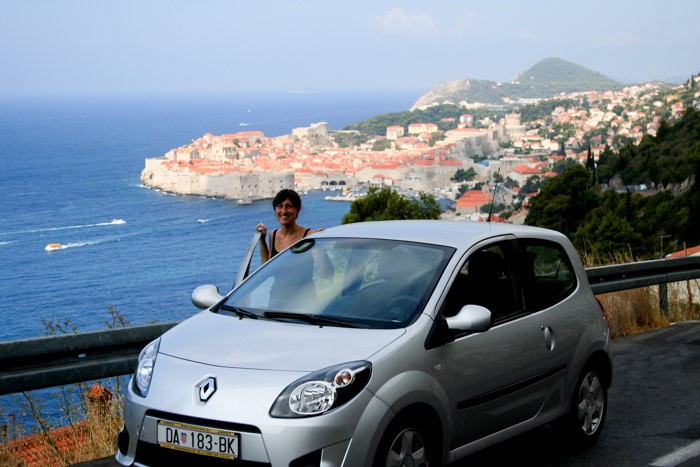
Part of the reason we chose to base ourselves in Dubrovnik was its central location to the other towns (or country, as it may be) we hoped to see. We had decided to travel down the Adriatic coast to Montenegro.
Early the following morning, we caught a cab from our hotel and traveled through the old town to the Gruz neighborhood, the area around the new ferry terminal, where we found our car rental agency. We’d arranged the rental before we left the U.S. (with AutoEurope) and would have our Renault for 5 days at the rate of $225. From Gruz , we drove back past the old town—stopping frequently at pull-outs to take in the views—and south toward the border of Montenegro.
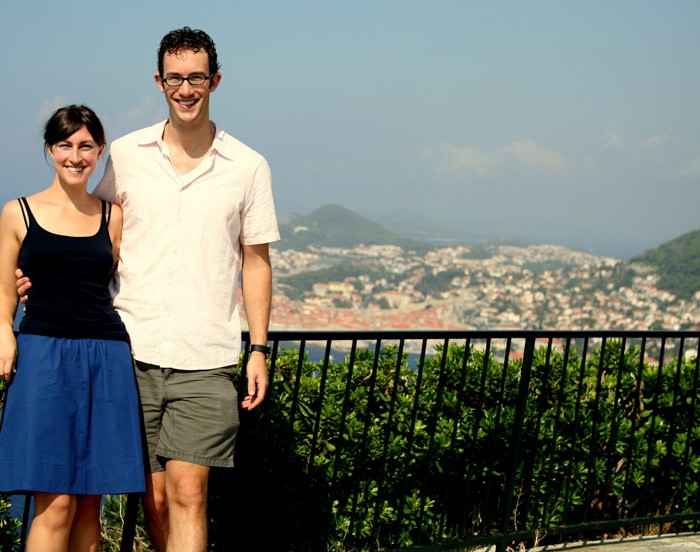
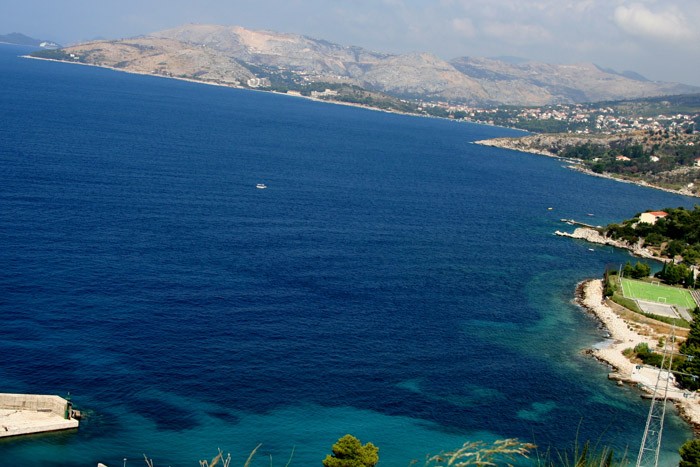
For my pick of favorite vista on our drive, it might be a draw between that of Dubrovnik’s red roofs and its white walls against the Adriatic, and that of a soccer field perched just alongside the turquoise sea. Can you imagine holding weekly practice there?! When we slowed to a stop at each of the border checks between Croatia and Montenegro, we caught up on our history—reading about the Ottomans, the Austrians, and the formation and dissolution of Yugoslavia. We were both engrossed with the complicated, though abbreviated, history lessons in our books and felt really grateful to have the readings with us on the trip.
Our Rick Steves
Historically, Kotor was a major rival to Venice and Dubrovnik, and it was able to resist outside pressures for years because of its geography. A narrow neck of the Bay of Kotor opens to a huge expanse of water with steep mountainous walls on each of its sides.
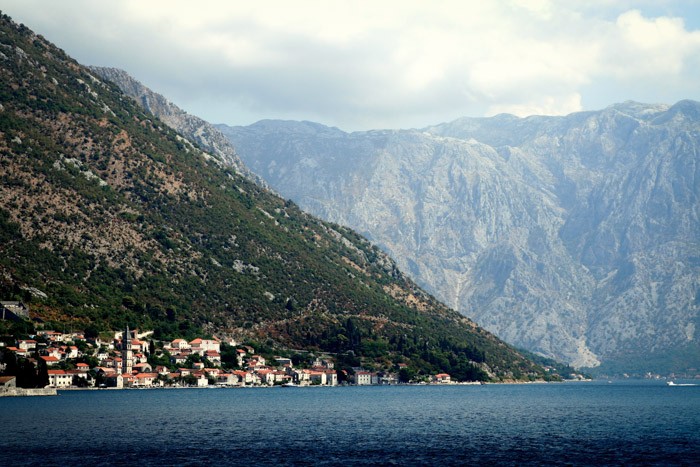
Looking at the strait, we could see how well this bay could be defended. The bottleneck’s defenses, we learned, included the laying of rope across the bay and the placement of submerged blockades in its depths, while the incredibly steep mountains would stop most land invaders.
After passing by a few unsightly soviet-style concrete blocks (once upscale retreats), we stopped in the village of Perast—which was filled with ornate mansions in the 17th and 18th centuries. Currently, there are only about 150 citizens, most of who appeared to be occupying the docks by the water, enjoying the view and soaking up the sun. During its peak, there were around 1500 people living in Perast, and the 17 churches built by its residents were testament to their position of power in the Bay. We strolled along the water and took our 1,564th photo of a charming, rustic boat floating in the azure water, and admired the old buildings.
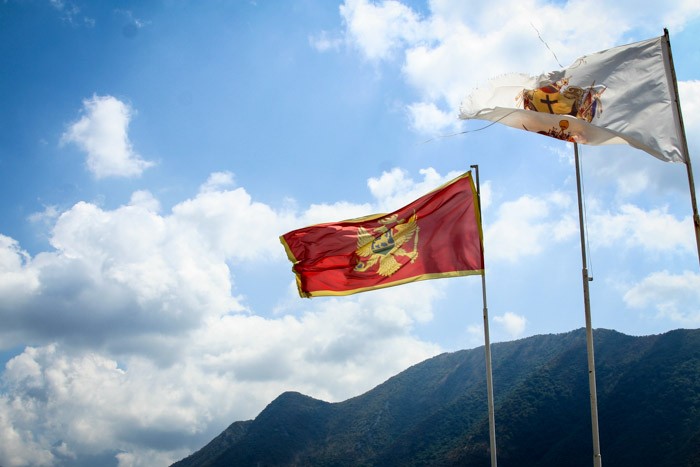
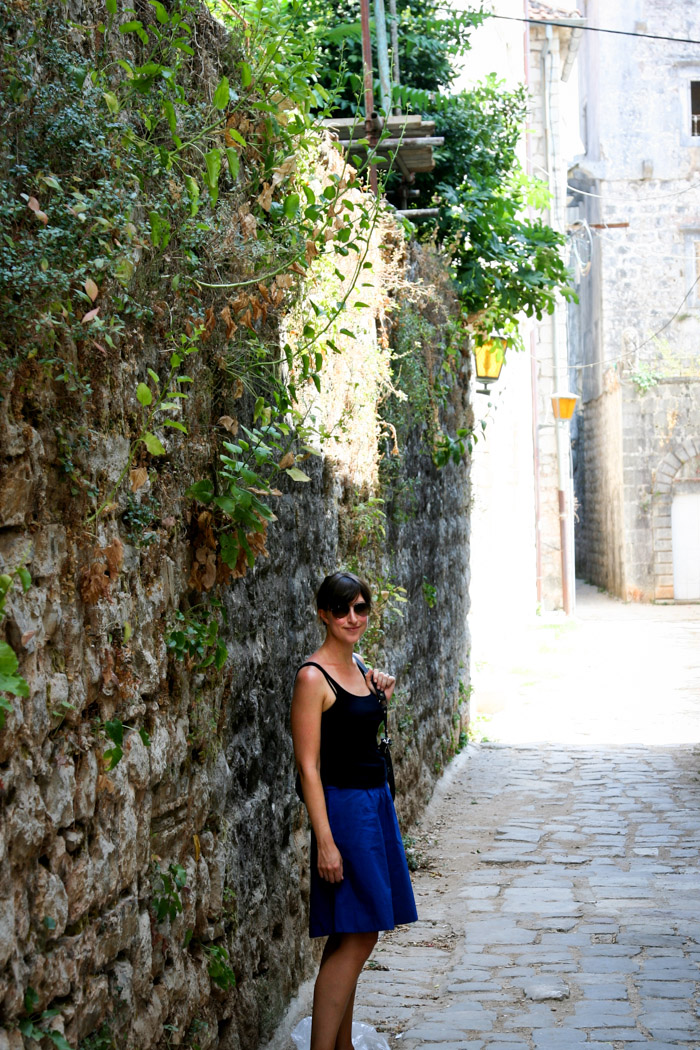
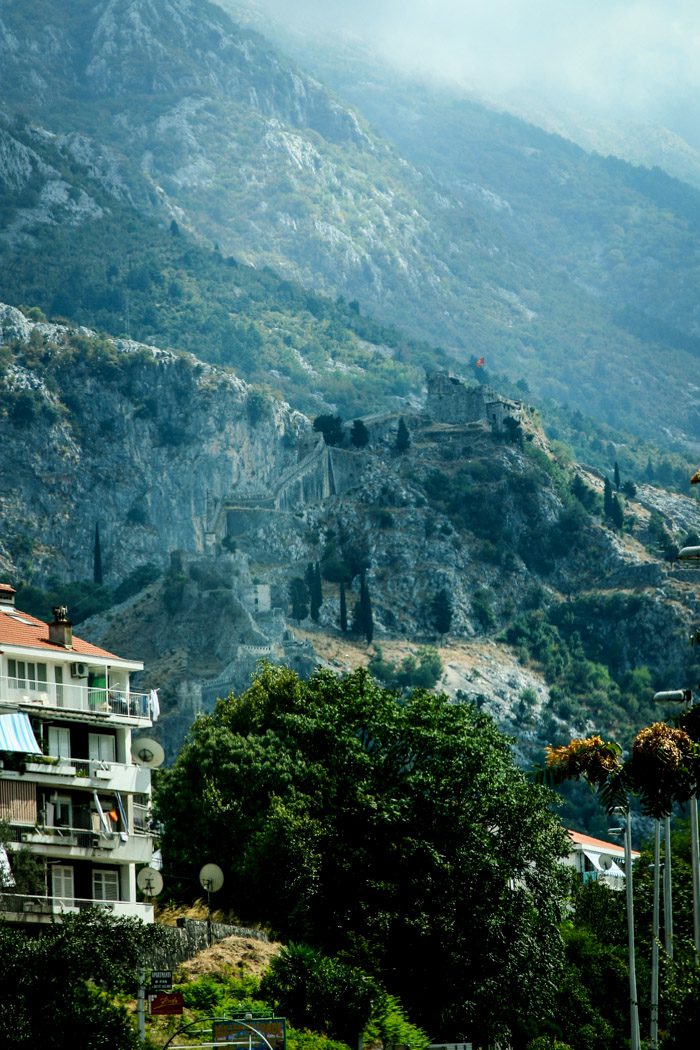
Once back in our car, we continued to drive along the edge of the bay, salivating at the mussel farms off shore. Ahead of us we could see the town of Kotor and, even from a great distance, we could already make out the walled fortifications climbing up the face of the steep mountain above it. We found parking near the docks, allowing us to marvel at the yachts on the way to gates of the city (such sightings—e.g., the boats with their own boats— were commonplace on this trip and never ceased to be entertaining and gawk-worthy). The gates once abutted the water—which added to the security of the city—but now the land had been filled in.
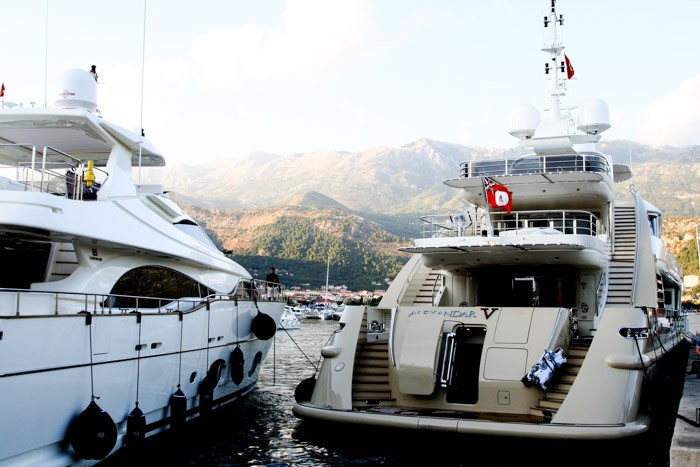
We walked through the gates where Venetian traders had transported goods hundreds of years before and into a small courtyard. The tiny little town proved to be a maze of courtyards and narrow streets, but we enjoyed losing our way (even as we did our best to see the sights—especially all of the Orthodox churches—highlighted in our guidebook).
Our first stop, however, was for lunch—at La Pasteria on a square facing the cathedral of St. Tryphon. After some pizza and regional beer, we sought our way to town walls for a hike. (Although I’m not sure an uphill climb is the best follow-up to pizza and beer on a hot, August afternoon!) The walls were built in stages from the 9th to the 19th century and varied in height and thickness. We made it up to a small church, about half-way to the top—from there we could go down without doubling back, so it seemed like a good alternative. The views were pretty amazing, regardless of whether we went all the way up.
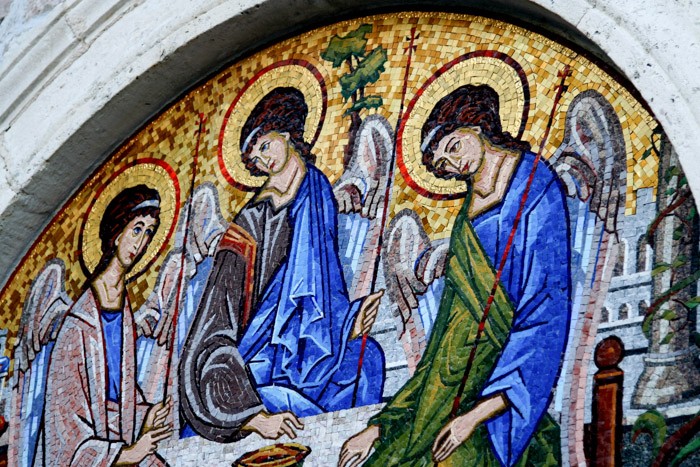
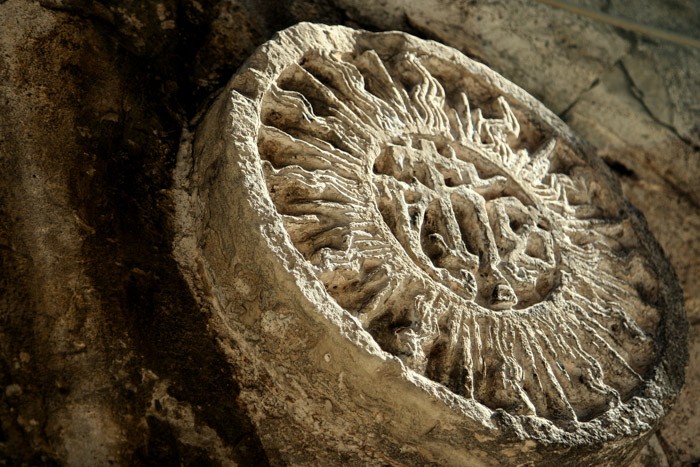
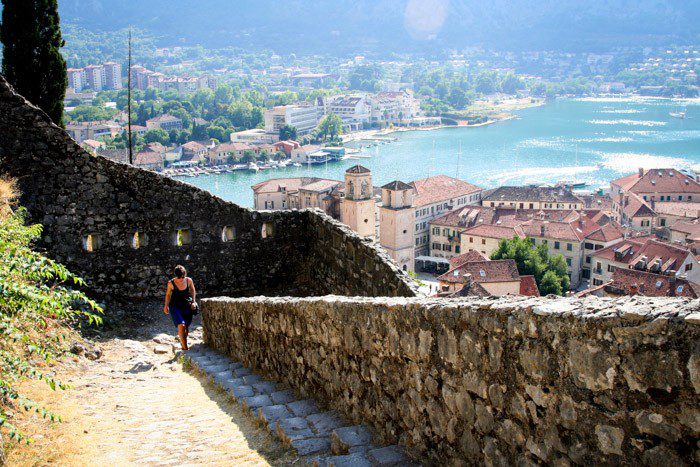
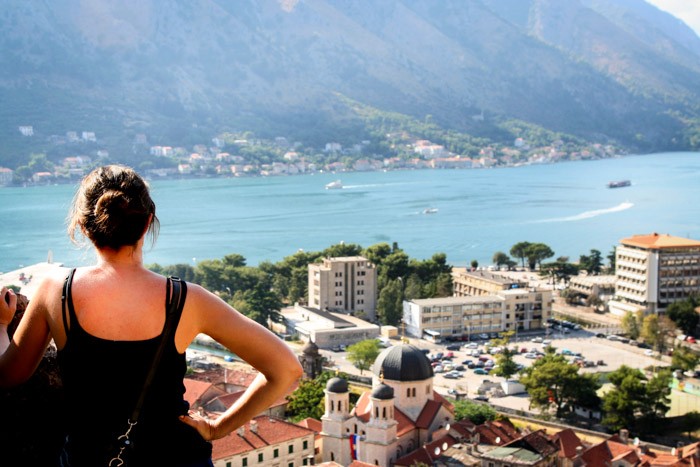
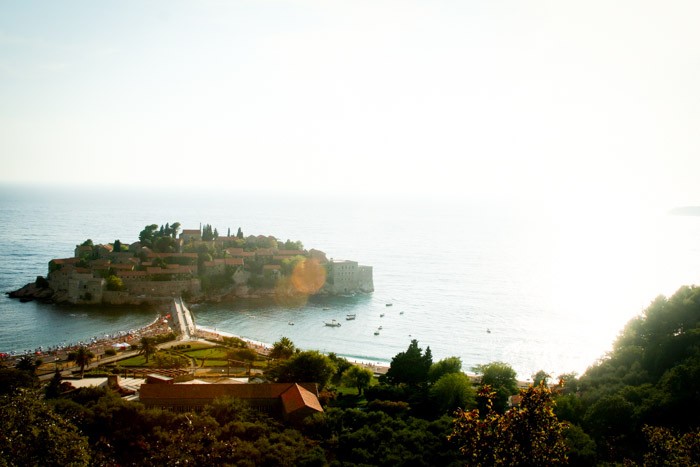
After looking around Kotor, we figured we had enough time to proceed to the Budva Riviera and the resort town of Budva. It’s about a 30 minute drive beyond Kotor. We went as far as the Sveti Stefan island (past Budva and closed while the Mandarin Oriental group makes it over), and then back to the town of Budva. We only spent an hour or so looking around, but we could see the appeal. It had a small, old town as well, but otherwise felt very new—more of a seaside resort for annual holidays. Apparently it’s a popular destination with vacationing Serbs.
We each had some sweets—Aron had not one, but two crepes—before deciding that we better hit the road.

We returned to Dubrovnik late that evening, and joined a line for one of the parking lots in town. The fee for the lot at the Hilton was 28 Euro, so we were determined to find an alternative. Once our vehicle had been stowed for the night, we set about finding ourselves dinner. We’d been meaning to check out Lokanda Peskarija, the restaurant at the port, and settled in for some hearty servings of beer and mussels.
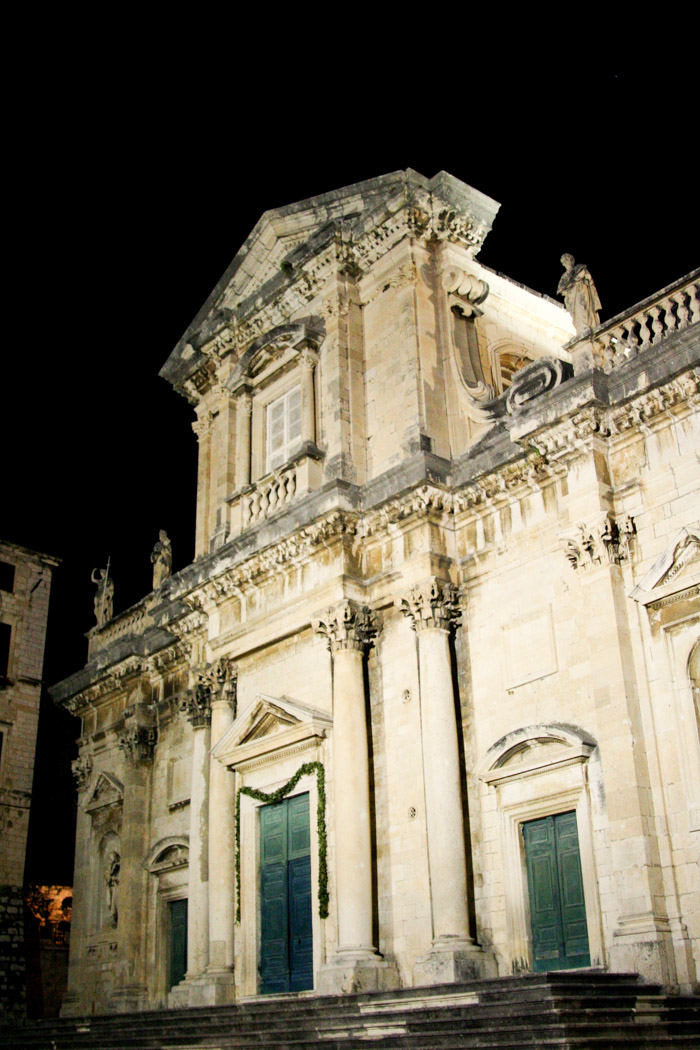
We stopped for some ice cream (though honestly, we were both underwhelmed with the all of the pastel-dyed ice creams, in general, despite all the claims of its rivaling Italian gelato), admired the buildings and monuments illuminated so nicely at night, and returned to our hotel to pack up our things. Sigh…
KORČULA & THE PELEJSAC PENINSULA
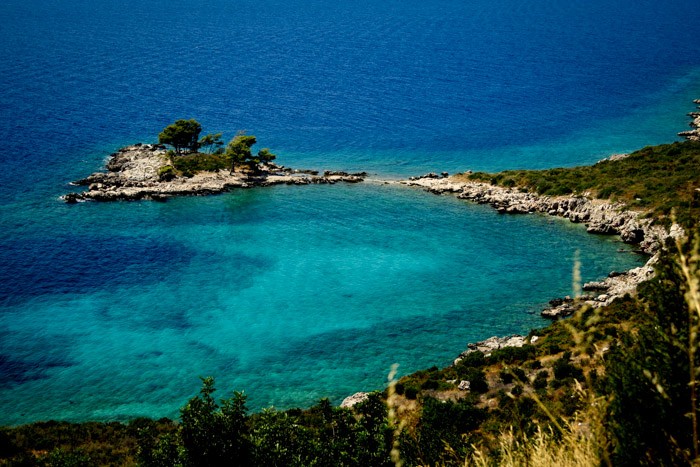
And off we went, heading north to the island of Korčula! I had posted querries to many message boards about our itinerary. I was worried about passing up the opportunity to take a ferry up the coast to hot spots like Hvar or Vis, but I really feel like we made the right choice to limit ourselves to these two home-bases.
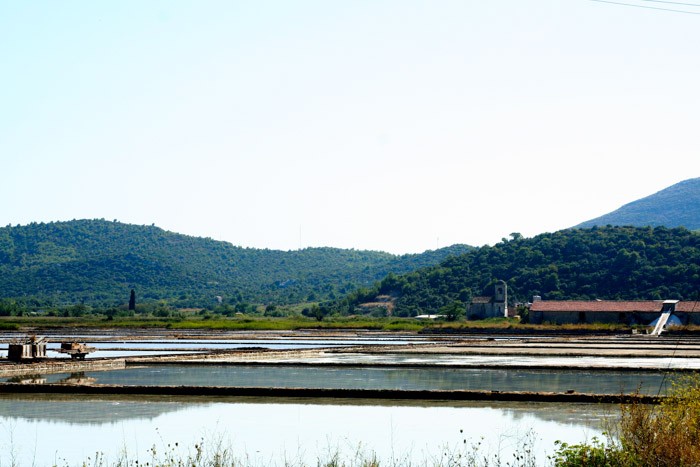
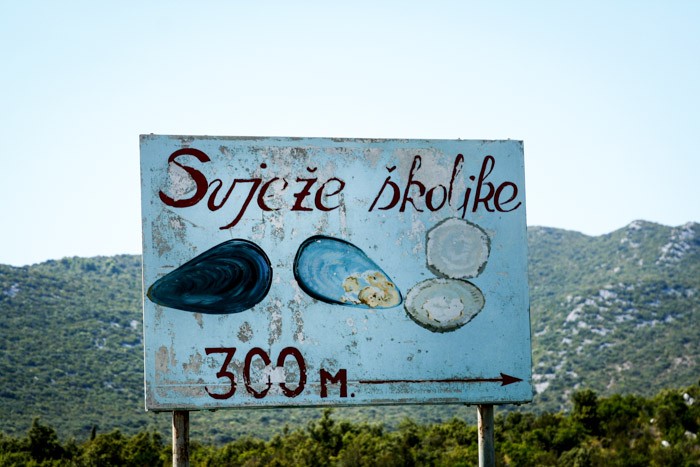
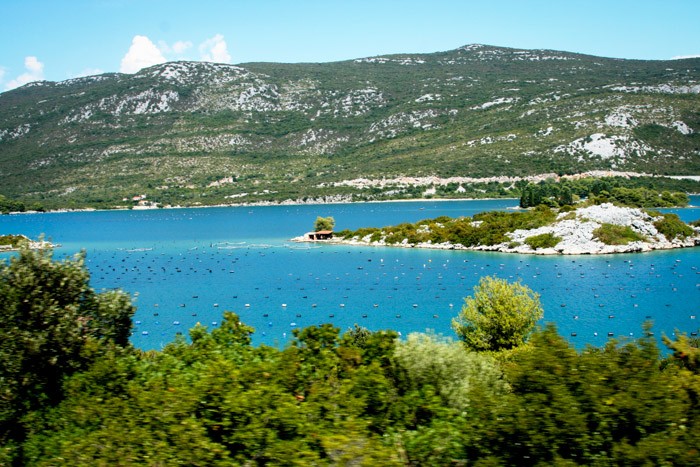
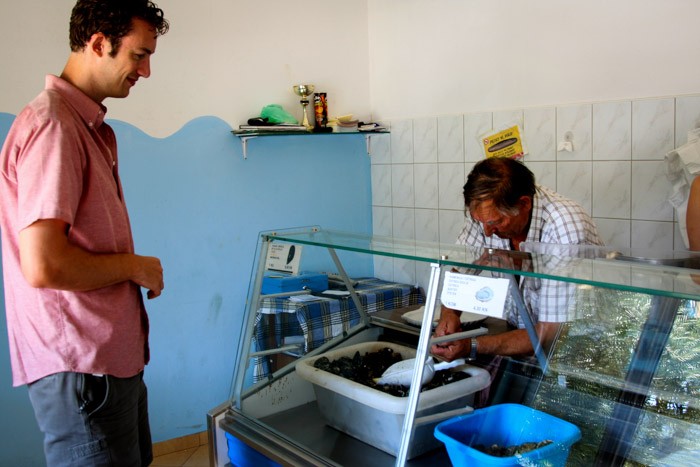
To get to Korčula, we drove about an hour to get to the Peljesac peninsula, stopping in Ston and Mali Ston before arriving at the ferry terminal in Orebic. Ston is an important salt-producing town and once served as a frontier to the province of Dubrovnik. Its fourteenth century walls are visible still. Mali Ston is known for its bays of oyster beds, so, of course, we couldn’t pass up an opportunity to sample some of the oysters at a streetside stand before lunch. We weren’t sure what exactly we were getting or how much we were spending, but with some pointing, some finger-counting, and lots of pleases and thank-yous we had ourselves a half-dozen oysters and some lemon wedges.
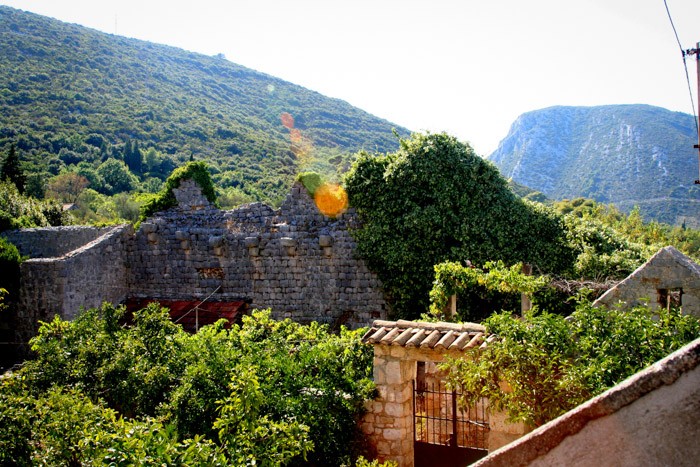
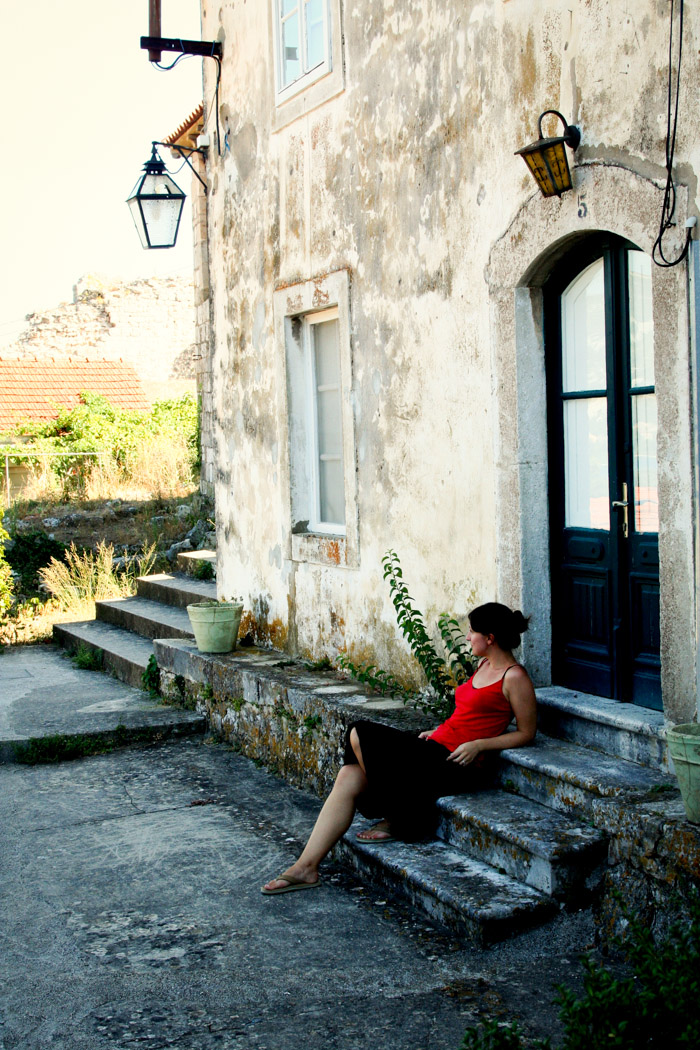
Once at the village, we chose to sit down at Kapetanova Kuca–recommended by both of our guidebooks, so we tested the merits of their squid and cuttlefish risotto and their “sea shell soup” (mussels and clams in white wine sauce) against those of our previous dinners. I remember it being delicious, but more so I remember sitting out by the charming little bay and walking among the dilapidated (but more lovely as such) stone buildings in the village. Mali Ston actually comes first on the road from Dubrovink to Korčula, so we arrived at Ston next.
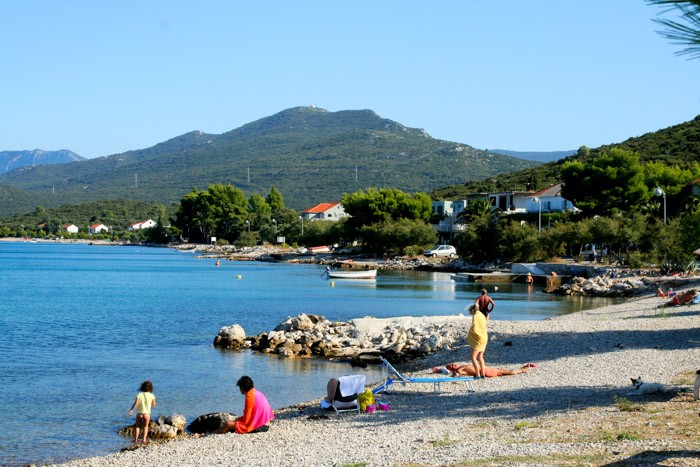
We passed up the opportunity to climb the walls—figuring we’d done our hard walking in mid-day sun already—and instead went for more food at a farmer’s market.
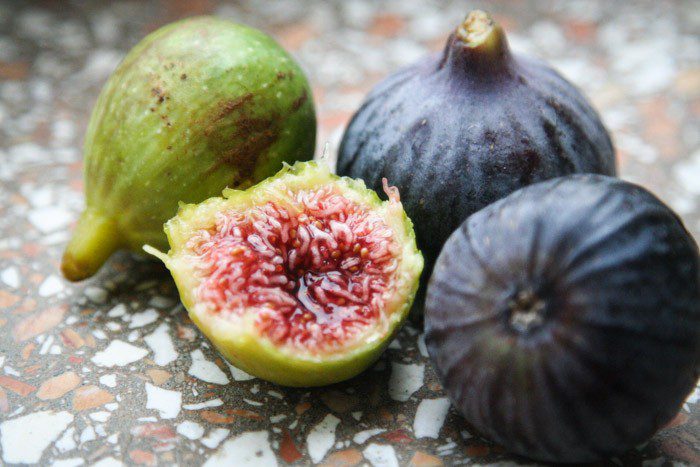
We couldn’t get enough figs during our time on the Dalmatian coast. Any shade, it didn’t matter, the figs were amazing! We’ve never tasted better.
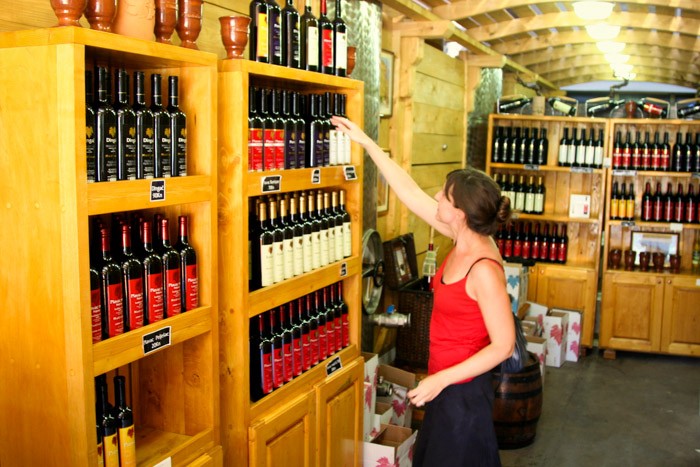
So with our sweet tooth fixed, a few wine bottles in hand, we pulled into the town of Orebic and saw that a ferry was in port and that there were cars pulling onto the loading dock. I ran out of the car, quickly found my way to a ticket stand—where, of course, someone ahead of me was trying to learn about the next day’s times—and did my best to look just anxious enough such that the vendor might try to help me right away. With tickets in hand, I rushed back to Aron, and we pulled onto the ferry just before it went on its way. Had we missed this one, another would have left in an hour—but we were glad to be on our way to Korčula.
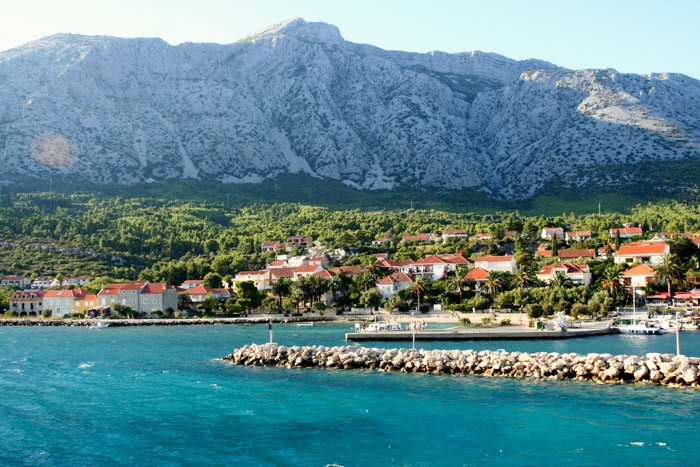
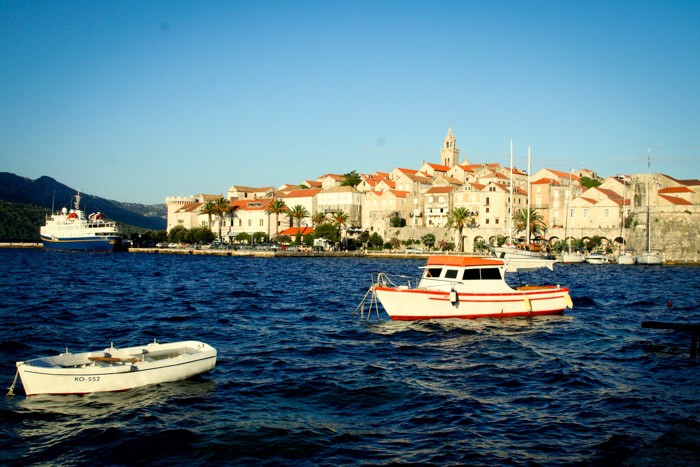
Korčula was probably the highlight of our time in Croatia. Its small island charm was exactly what we were looking for; we especially appreciated being able to base ourselves in Korčula town while spending the days finding less populated spaces.
From the ferry, finding Korčula town was easy, but getting to our sobe—a room rented in a private residence–was only slightly more challenging. Only a European car could squeeze down the narrow street that lined the coast—luckily ours fit the bill. A few hundred yards past the gate into the walled city, our sobe awaited us.
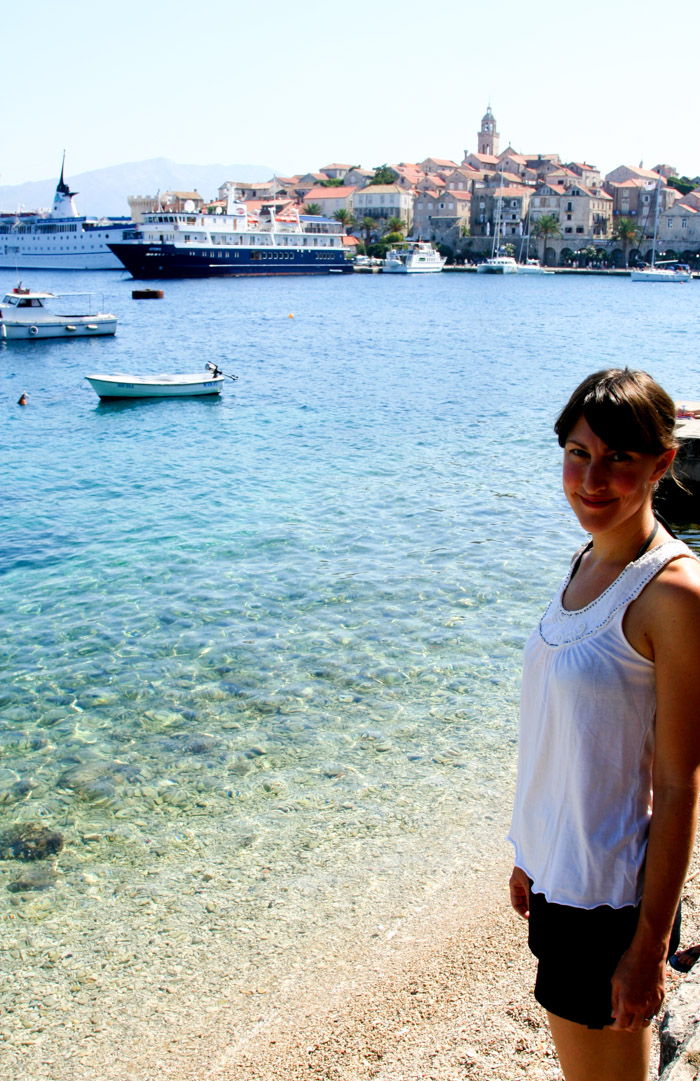
Ours was on the second floor of a yellow house that sat just across the road from the beach: Apartments Depolo (owned by Rezi and Andro). We had an excellent view of the crystal clear water below and the city just down the way. Rezi welcomed us in, showed us where to park, and gave us a tour of the room and common spaces. There was a common refrigerator and outdoor space. Our room had one full size bed and one single bed, a small table and chairs, a bathroom, television, and coffee pot. One could pay a supplement to use the attached kitchenette, but we declined. After our look around, we dropped off our bags and set out to explore.
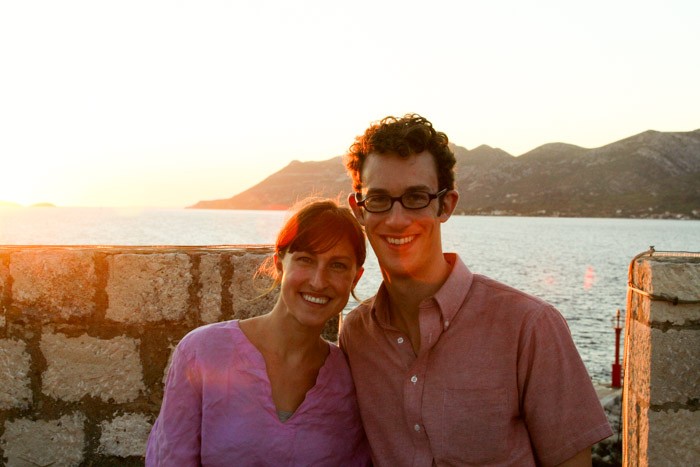
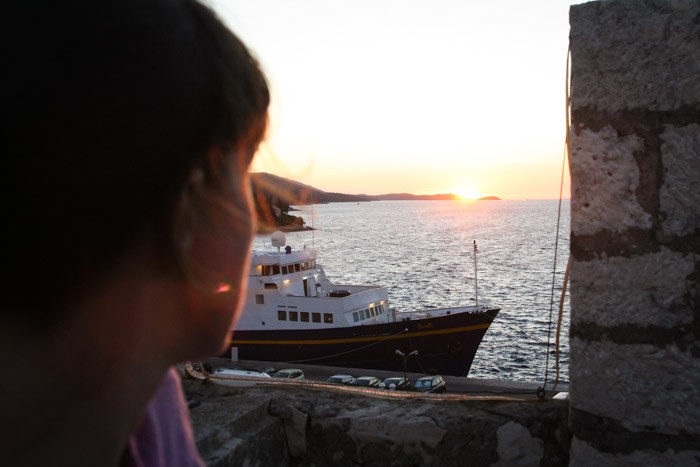
Korčula is often described as a miniature Dubrovnik; it has a similar feel, with its stone buildings and winding pathways, but the stores are smaller and the restaurants more quaint. It felt good.
In our wanderings, we happened upon the southern tower and found that it had been converted into a bar. After the first, easy flight of stairs, we then squeezed our way up a narrow ladder, through a small hole in the floor/roof in order to reach the top of the tower. It was the perfect perch from which to watch the sun set. We found a seat on the edge where we could overlook the water, the city and, most importantly, the pulley-system that sent drink orders down and brought the orders-fulfilled up in a wire-basket.
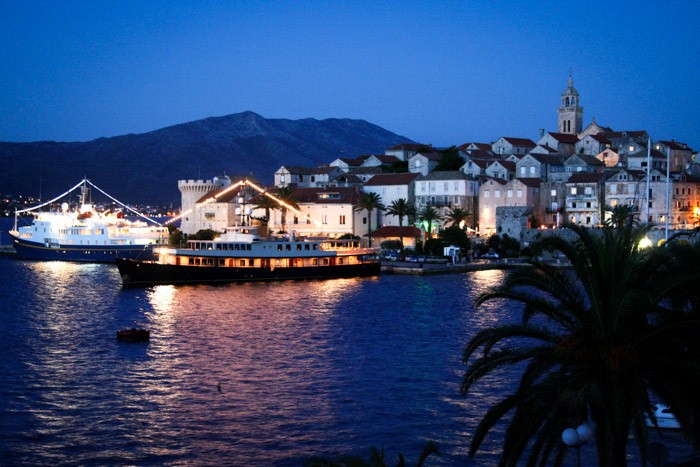
Aron and I settled in with our libations next to the turrets—from where, hundreds of years earlier, the city was defended—and watched the sun color the city walls before it sank into the sea. I later found that the bar was inour books and is called Buffet “Massimo.”
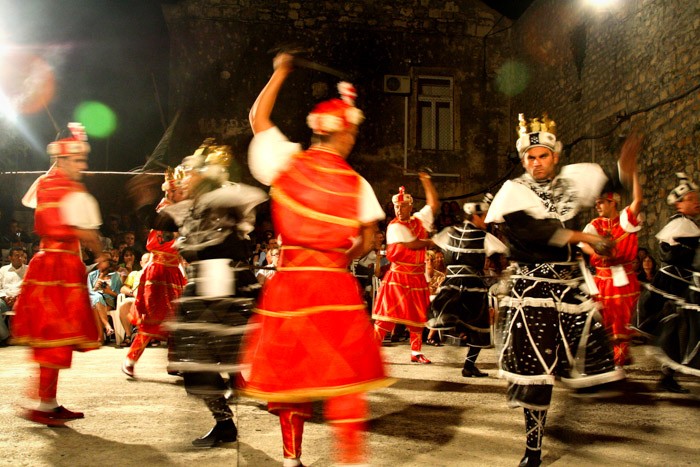
We were fortunate that, walking back into the city, we happened to pass by the city cinema. During the summer, the Moreska dance is held every Thursday in Ljetno Kino—a small open-air stage right on the edge of the Old Town (which also doubles as the cinema). We had planned to go, as Korčula is well known for its performance of the centuries-old dance, but had lost track of days and thought we had arrived on a Wednesday. Fortunately, we were able to get tickets. I waited in a line to enter as Aron tried to hunt down some provisions to hold us over for dinner. The show began with an acapella performance—the harmonizing sounded amazing in the echo-ey space—before the dancers entered. The Moreska is a sword dance that came to Korcula in the 16th century and is associated with the battle between Moors and Christians.
The story plays out as two kings fighting over a princess, but the story is less compelling than the sword fighting. Each member of each king’s army dances in circles clashing swords—first slow, thenfaster, and faster. Sparks fly as the metal clashes, and the dance gets increasingly intricate. It’s clear that any misstep could be very painful for someone involved. At one point, a handle broke off from one of the swords and went flying toward the audience. It landed about a foot away from the 6 year old sitting in the front row.
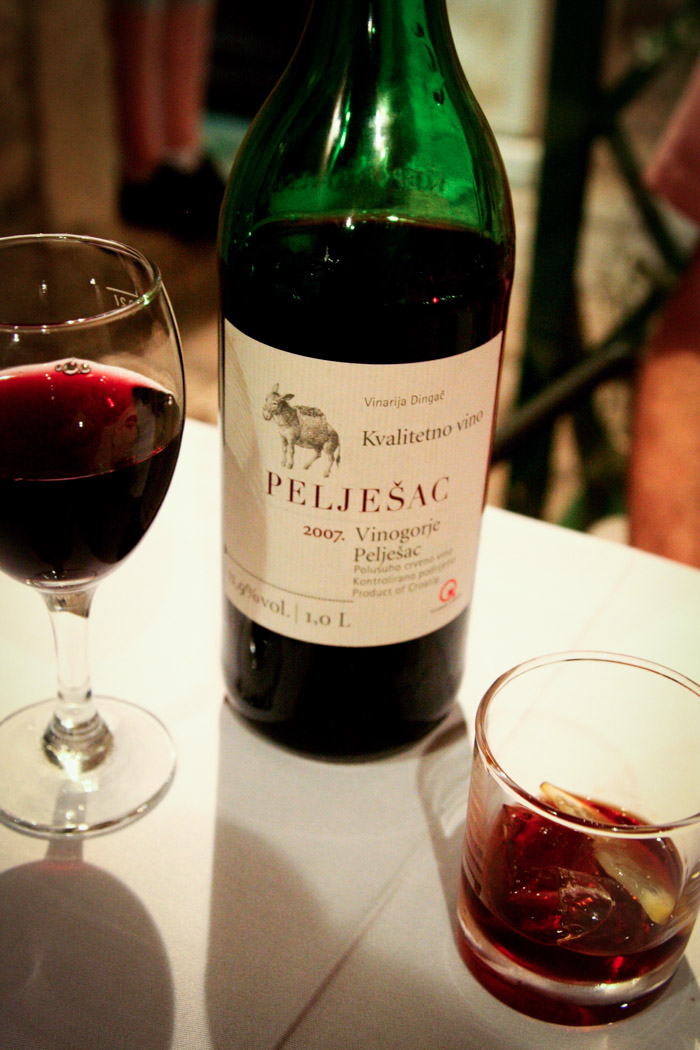
We made it out unharmed, and had a late dinner at a pizza spot nearby (Pizzeria Amfora—which also turned out to be in our Rick Steves’ guide); Aron had a glass of Amaro and we shared a bottle of local Dignac.
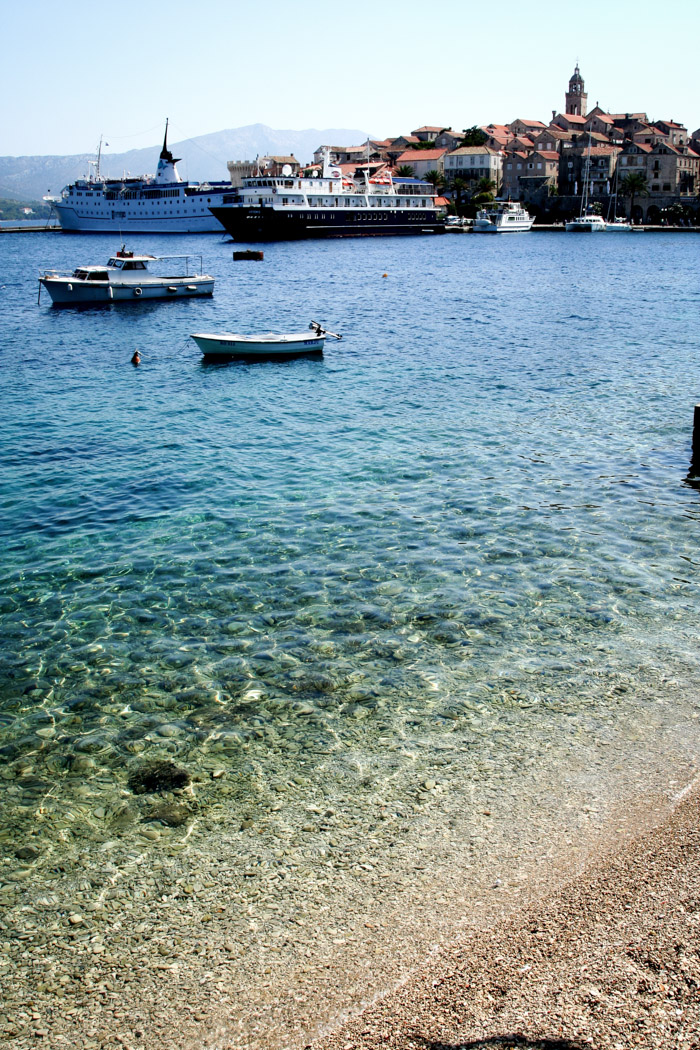
The next day, after picking up some drinkable yogurts and some excellent pastries (one cherry, one fig), we set off in our Renault to explore the entire island. In Ston, we had stopped at the roadside visitor’s center and picked up some brochures with maps of the island. Using a combination of the winery guide and a booklet describing the various beaches, we did our best to prioritize.
It’s a surprisingly necessary step. Although the island is only about 29 miles long (and only about 5 miles wide), the main road runs directly down its midline—which also happens to be the most elevated point—so each little cove or town can actually be quite a drive (often a windy one) from the main road. I should mention that Time Out and Rough Guide both had more information about Korčula Island—Rick Steves only discusses Korcula Town; still, we found most of our driving guidance from a local island map.
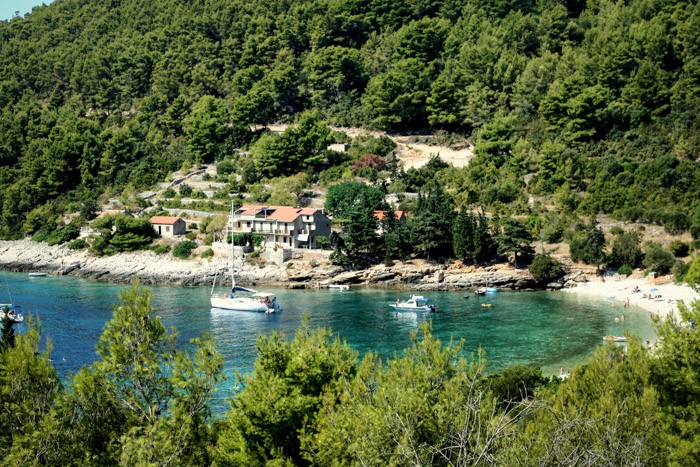
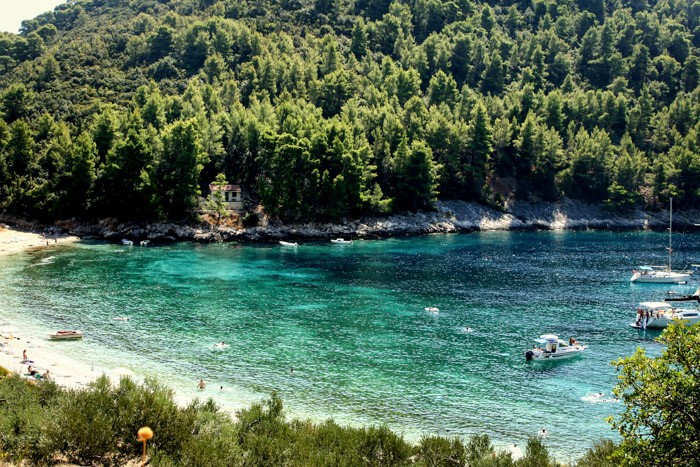
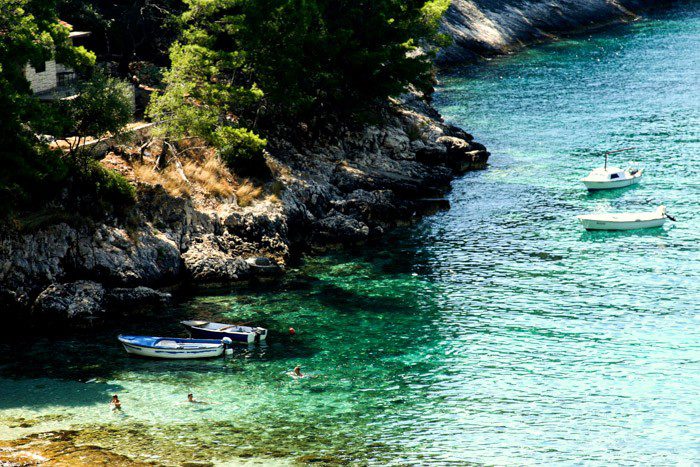
One of our first stops—one which we vowed we would return to again—was Pupnatska Luka. I just love saying the name: Pup-nat-ska Luk-a. Down a dusty dirt road, (which was so incredibly windy and so dusty that it nearly deterred us) the little beach was exactly what one wants. Lovely azure water, sparsely populated, off the beaten track, and it had some chaises and umbrellas for use!
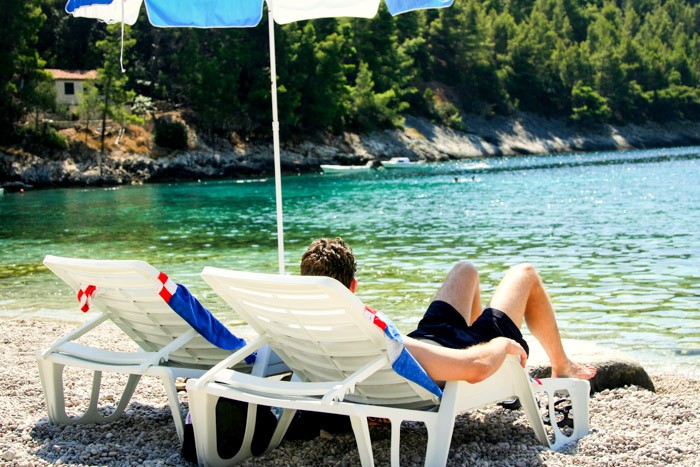
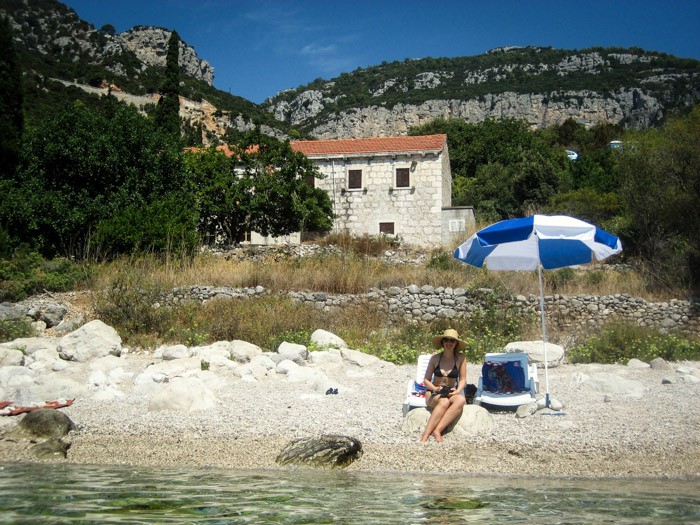
After a short stay, we continued on our way, stopping at one of the roadside wineries. Paval Banicevic, the young man who helped us at Toreta Vinarija Winery in Smokvica village, was a fourth generation vitner and explained that their small production is due in part to a shortage of labor supply. Almost every family in the region has a vineyard and needs the help of everyone in their family to tend the harvest. One can’t just borrow some help from the neighbors. We left with a bottle of wine and a bottle of olive oil—wonderfully spicy, grassy flavored green olive oil.
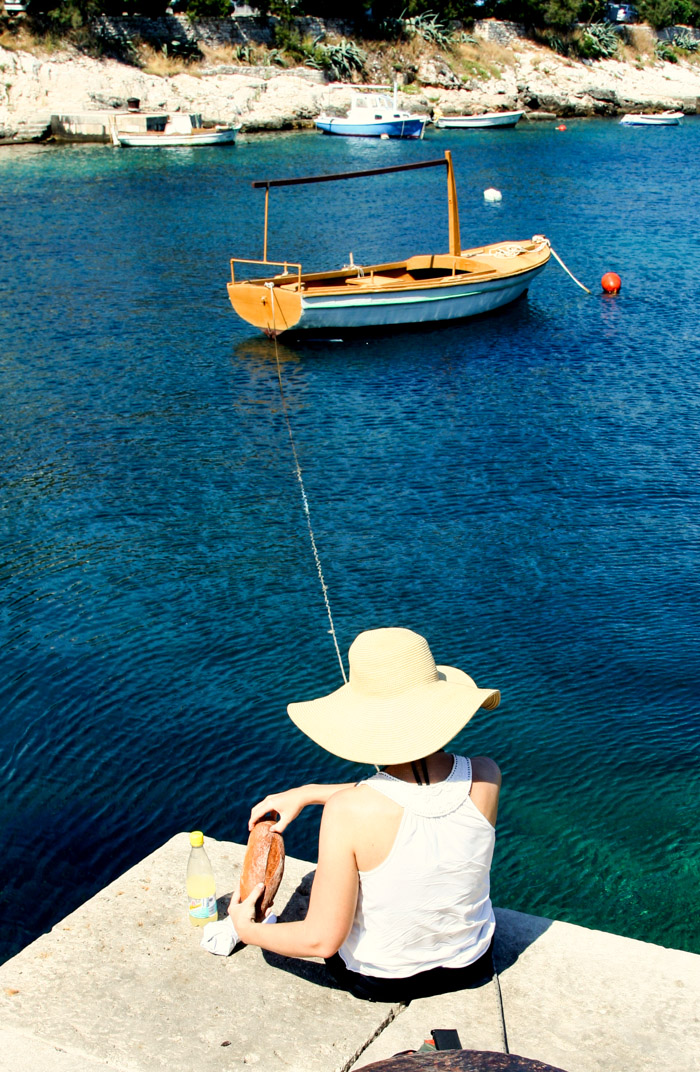
For lunch, we stopped at a market and picked out some cured meats along with cheeses and bread. The baguettes tend not to have that same crunch one comes to love in a French baguette, but the lunch was especially nice when enjoyed sitting on a dock in a small village’s harbor.
That was just one of the lovely views to be taken in that day. We had a wonderful time driving about, climbing hills and looking at the red roofs of one village before dipping down and following the coastline to another. On our way back toward Korcula, we stopped at Lumbarda to see one of the most popular beaches near town. It has sand instead of pepples, which—again—I think is overrated, but we knew we would be returning to Pupnatska Luka regardless.
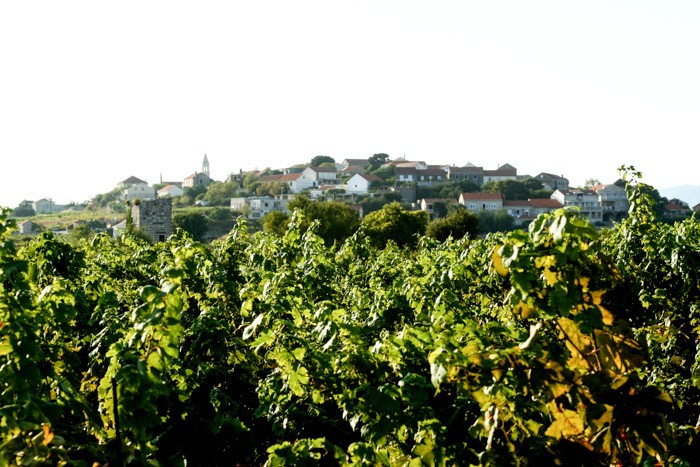
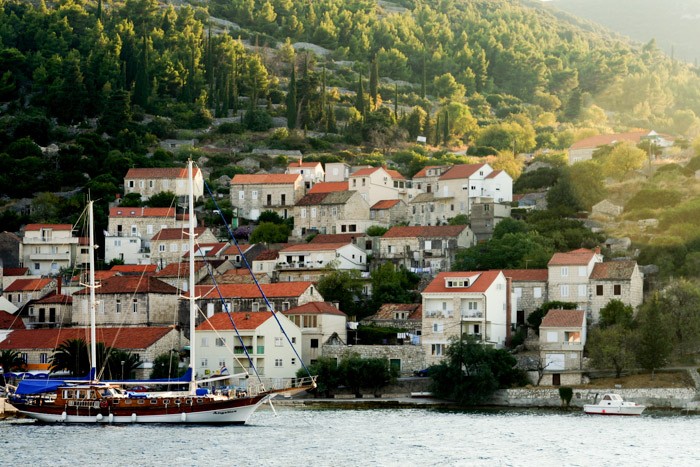
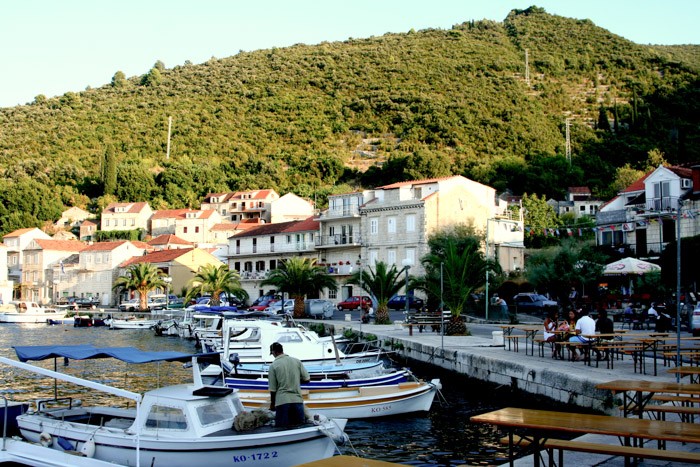
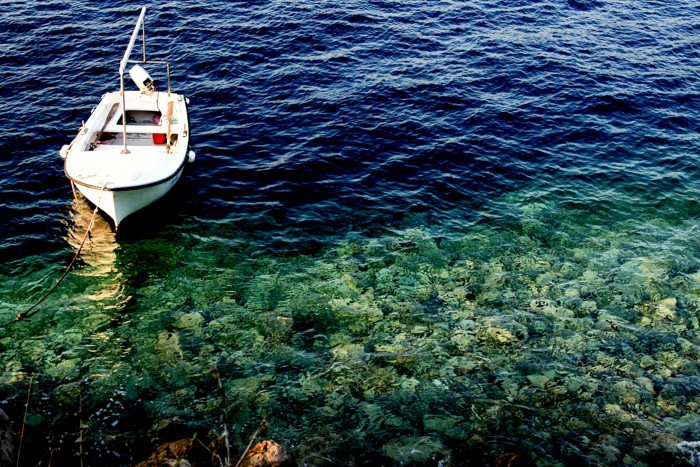
Next came the village of Racisce. Surrounding a charming, petite harbor, we found men playing petanque, a small market, a lovely church, and some permanent picnic tables perfect for enjoying some local beer. We looked on as a father tried to pull his sailboat up to a buoey and saw his efforts thwarted at every try as his useless teen stared from the stern. And we watched with fascination as two young men in speedos did laps, running and swimming, in circles around the harbor. I remember this especially, because we saw them repeating the ritual again the following night.
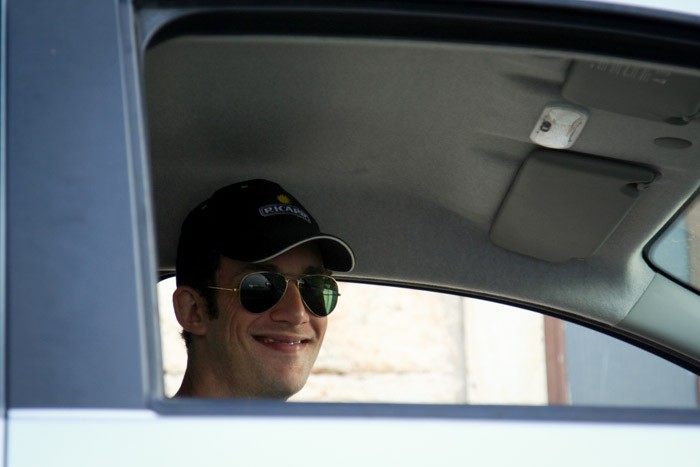
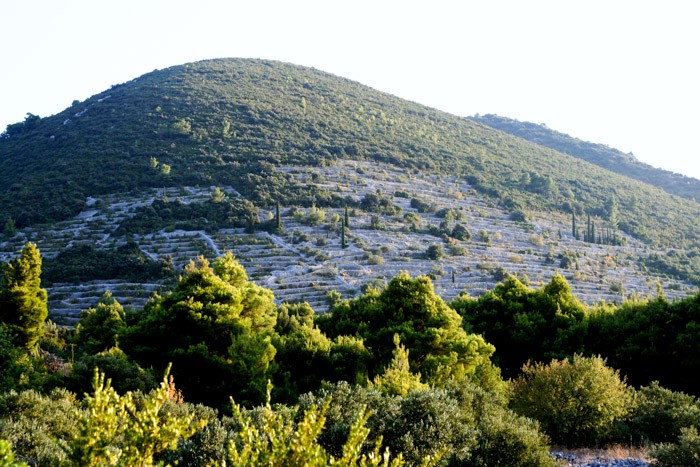
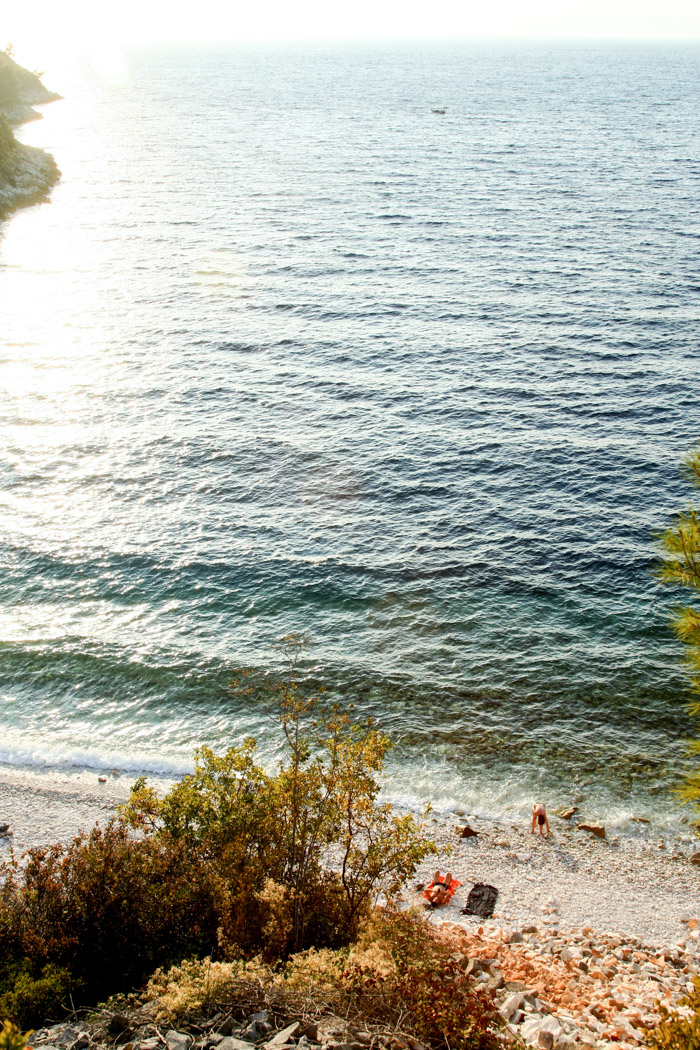
Our last stop that evening was at a beach I believe is named Vaja. We followed the road down to its end, but were still quite a distance from the shore. We could see our destination, however, and it was so stunning that we began to slowly maneuver our way down the very steep hill. The hair-raising descent was well worth it: despite our initial decision not to swim—the sun was low, and we’d discovered that the water in Croatia could be quite chilly—we found ourselves compelled.
And it was wonderful. The beach was lovely in completely different ways than the others, with its bright, bleached-white stones.
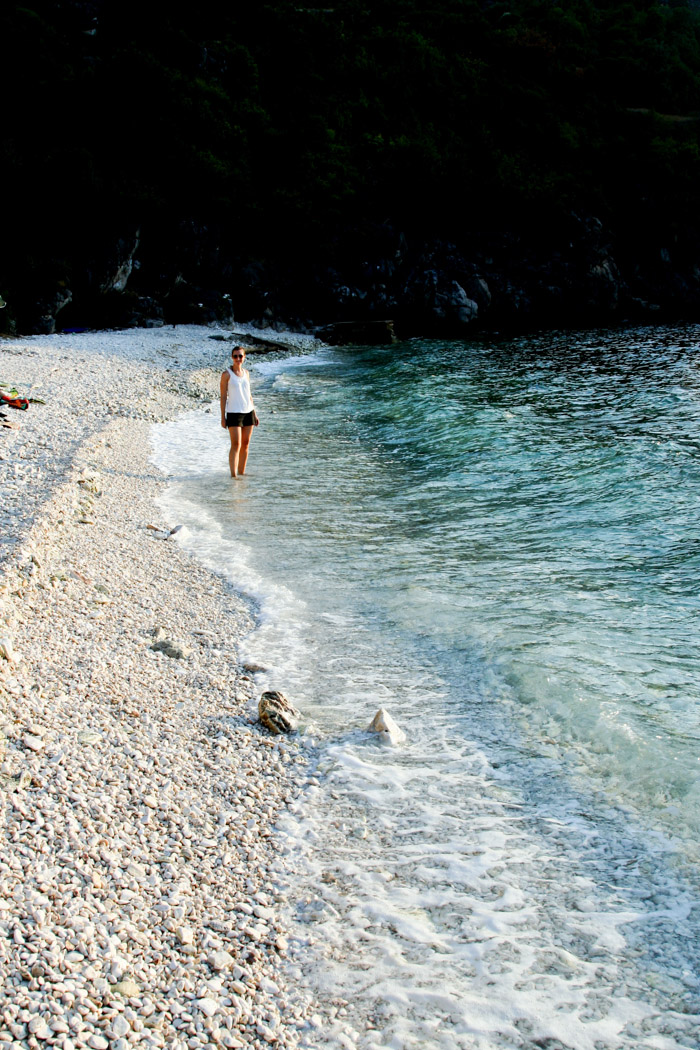
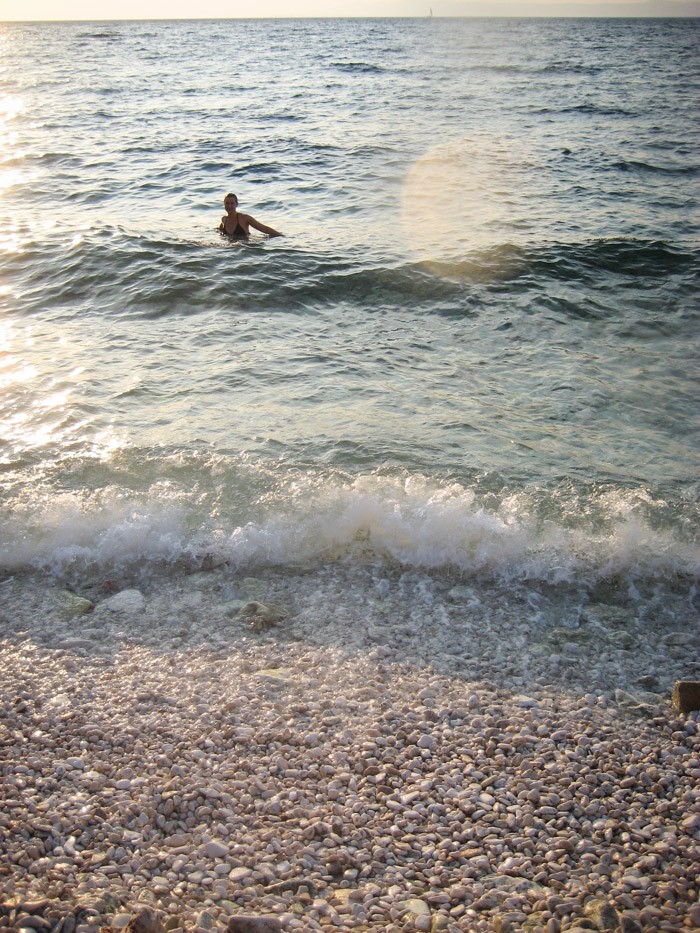
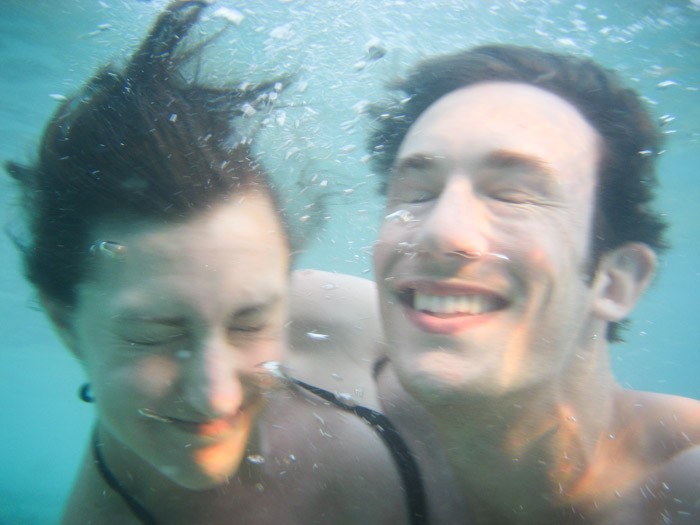
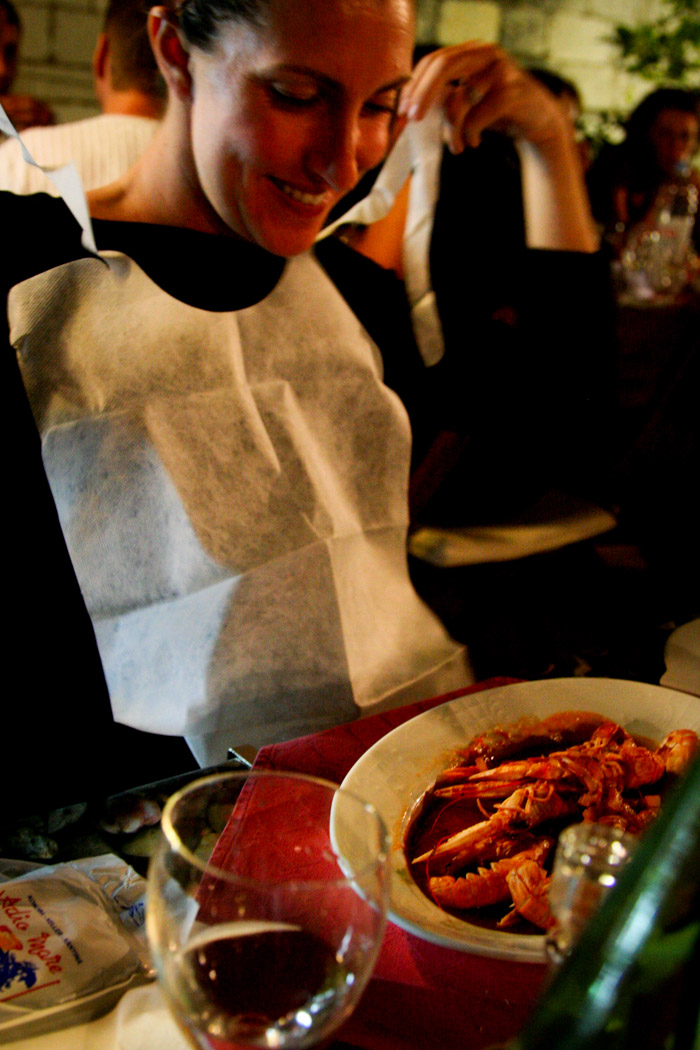
For dinner that night, we tried the highly recommended Adio Mare. I donned the house bib for the shrimp (Scampi Buzarra). I’m not sure I’m ever going to really be capable of enjoying eating shrimp with their heads on and the little eyes looking back at me, but the buzarra sauce was indeed delicious.
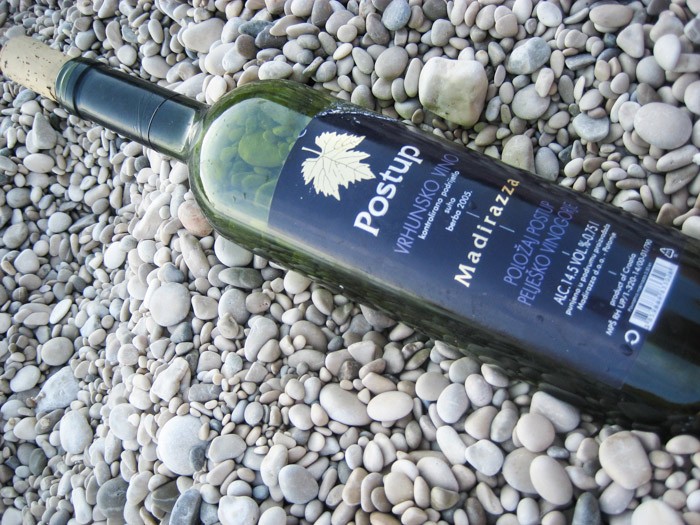
The next morning, we went back for the cherry pastry, but had to settle for apple instead. So with apple pastry and some additional drinkable yogurts, we packed up a bottle of Postup wine, some reading materials, and the rest of our beach gear to return to Pupnatska Luka for the day. There, we rented two chairs and an umbrella, taking breaks from sitting and reading for an occasional snorkel and swim. Maybe we napped, too.
On the way back, after another couple of beers at Racisce’s tables, we had to pull to the side to fully appreciate one of the most beautiful sunsets. Ah… tough day.
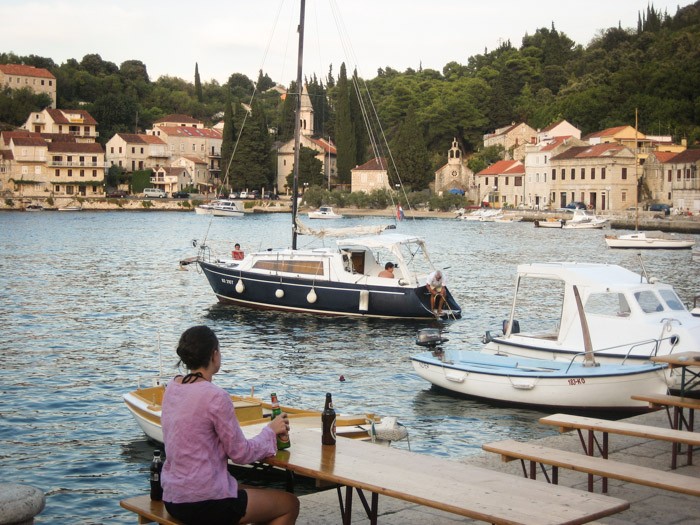
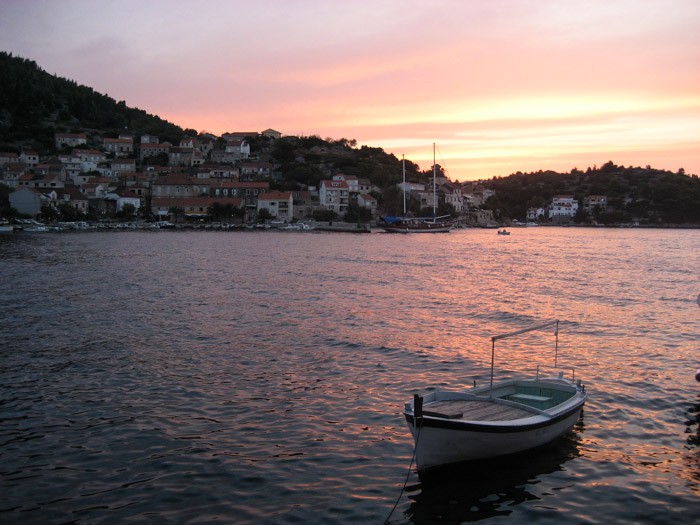
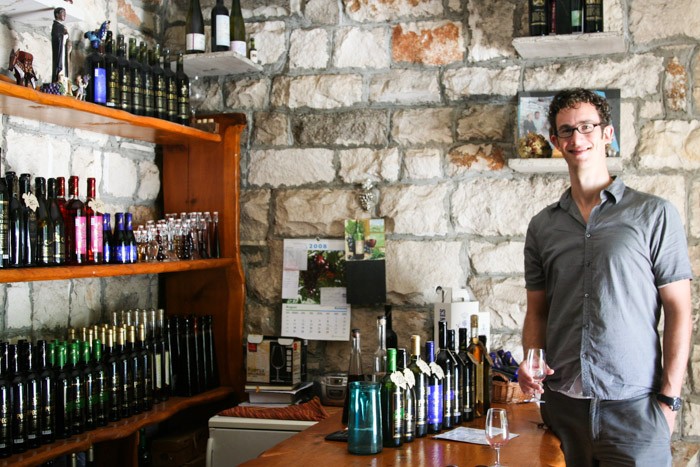
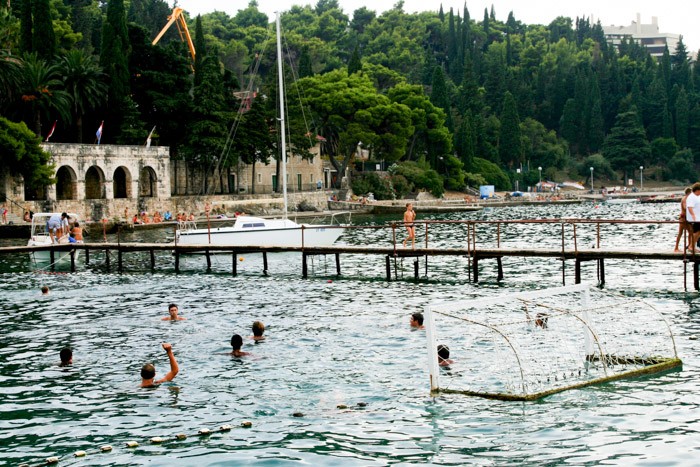
On our way back to Dubrovnik, we again took our time driving along the Peljesac Penninsula and made stops at a larger winery by the name of Matusko and at some of the beaches on the warmer, channel side.
BACK TO DUBROVNIK
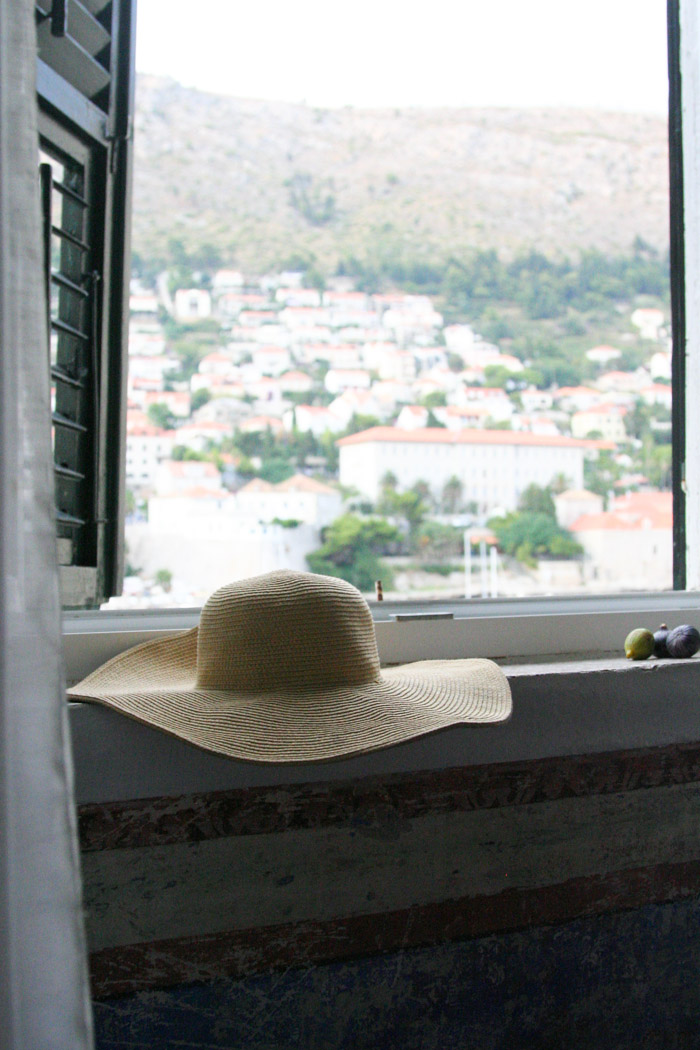
Later that afternoon, we returned the rental car and took a taxi back to the walled old town. We had found a sobe for our return stay in Dubrovnik. Renata Zijadic’s rooms were listed in our Rick Steves guide. She and I had emailed and she asked only for my word to hold the room (so I was careful to keep her updated about our late arrival). It took us a little ambling up and down stairs to find the exact location, but once we arrived we were treated to a fantastic view of the harbor.
Our room shared a bathroom, and was without a/c, but was quite comfortable and lovely—and a great value.
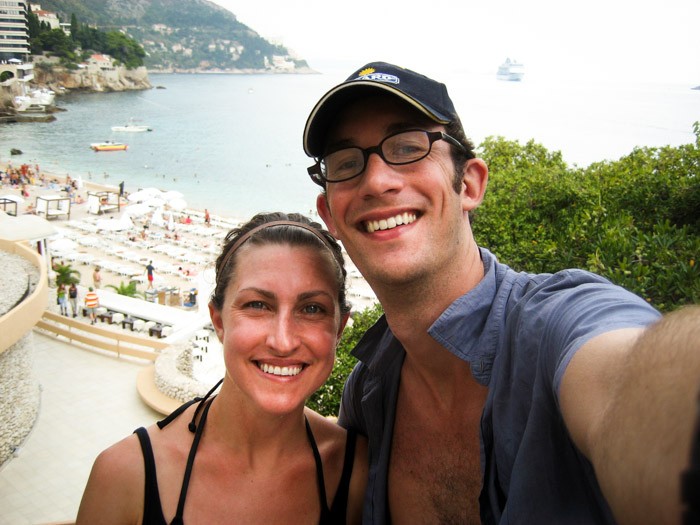
On our way to Renata’s we had stopped at Proto to make dinner reservations; so after getting settled and taking a stroll around the city, we made our way to the restaurant. Our book had warned us that though this would be one of the most memorable restaurants we’d visit, it was going to cost a pretty penny.
It was indeed quite expensive, but one could save by being more selective when ordering (deciding to share an appetizer, only order a main, for example) and still enjoy it. In fact, this is exactly what we chose to do the following night. While we enjoyed the food in Dubrovnik, I do have to admit that we were never blown away. And the prices were never low. So we felt we would prefer to spend a little more for this place where everything had been outstanding, than risk feeling we’d overpaid for an average meal on our last night. I was particularly thrilled with the presence of truffles on the menu—always a welcome find.
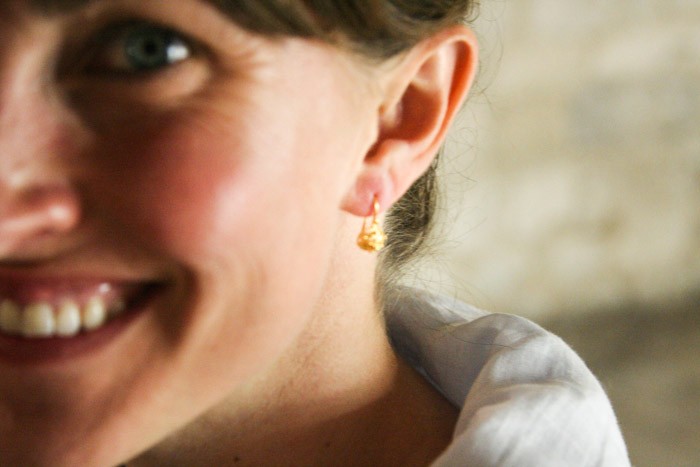
For our last day in Dubrovnik, before we dined again at Proto (this time upstairs on their balcony instead of at their sidewalk tables), we spent another day at Banje beach (Aron picked up provisions and we had lunch at the beach), and did some window shopping. I was thrilled, however, when Aron suggested we take a closer look at the Konavoske Puce (“buttons” made from gold in a filigree-style) that can be found in many of Dubrovnik’s jewelry shops. My button earrings are one of my favorite gifts ever, and they are a great reminder of our wonderful trip.
ZAGREB
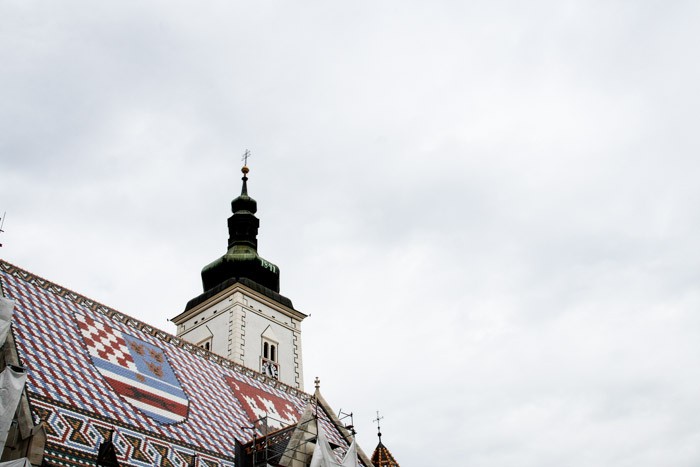
We left early the next morning for the airport (I had payed Renata for our lodging the previous day in anticipation of having to tip-toe out) and, after a brief touchdown in Split, landed in Zagreb about 2 hours later. We had a 5 ½ hour layover until our next flight. So with our bags checked, and some kunas left to spend, we quickly found our way to the shuttle connecting to the bus station. Once there, instead of waiting for the bus into town, we hired a cab to take us Trg Bana Jelacica and set out to see the capitol.
The square was filled with musicians and lined with craft booths, so we took our time there. Particularly impressive were the ladies giving demonstrations of lace making—their speed at weaving was incredible. We also kept an eye out for places we’d seen in our friends’ wedding pictures: we regret that a few years ago we missed seeing two close friends get married in Zagreb.
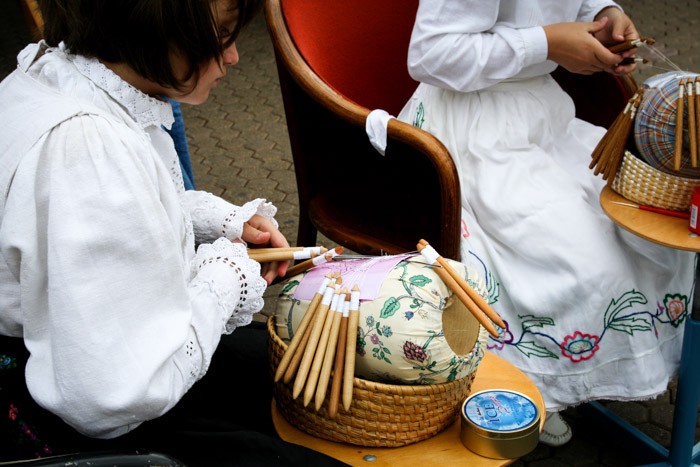
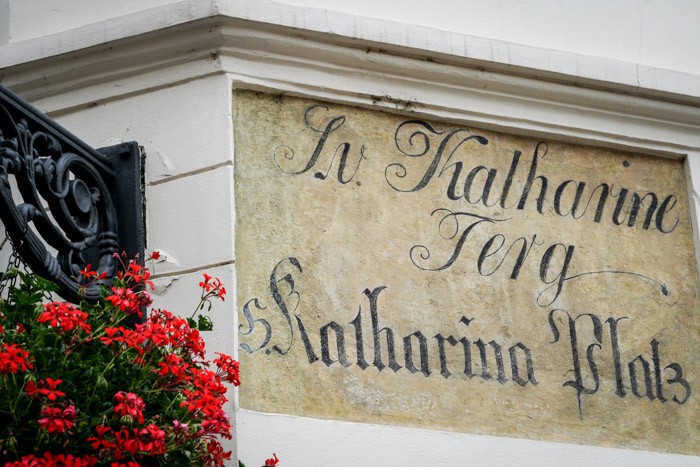
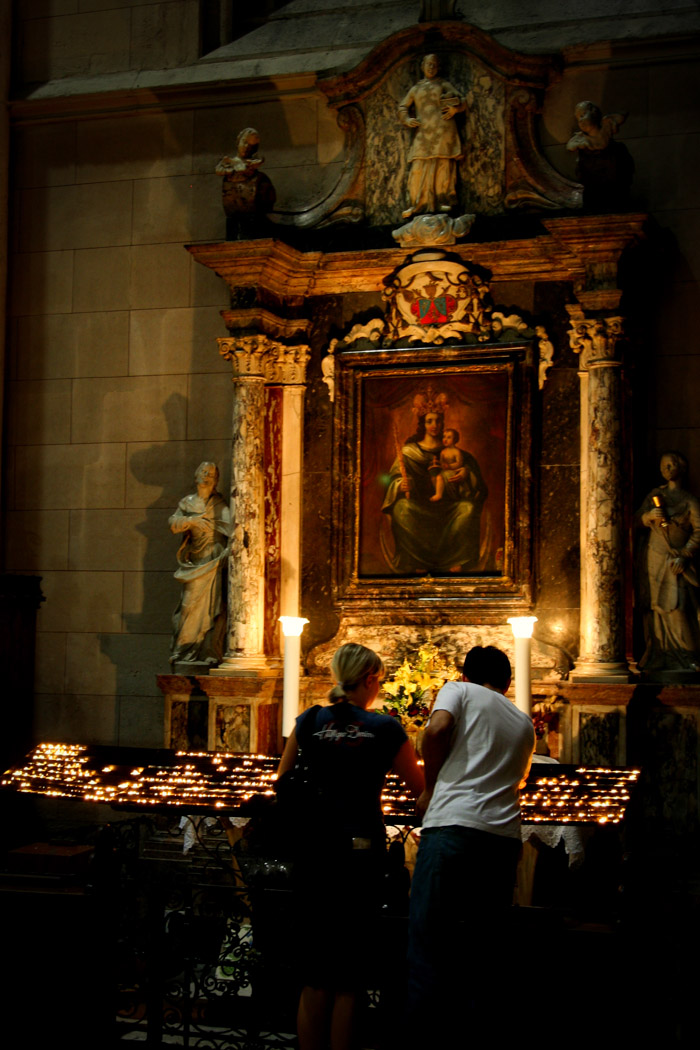
Rick Steves features a “Self-Guided Walk” for Zagreb, so we had an itinerary laid out for us. From the square we headed toward Gradec and Kaptol, passing by stalls of flower vendors, an elaborate iron-and-glass shopping gallery, and the funicular en route (we chose to take the stairs rather wait for a ride). Gradec features St. Mark’s Church with its colorful roof and some interesting holdovers from the Austro-Hungarian era—streetsigns, most notably.
To get to Kaptol from Gradec, we first passed through the Stone Gate (an old tunnel featuring a popular chapel to the city’s patron saint, Mary) and then found our way to the dolac (market) before ending up at the cathedral.
The market was huge, and packed with vendors selling all kinds of produce. Our final stop was at a park, where we were treated to some more music.
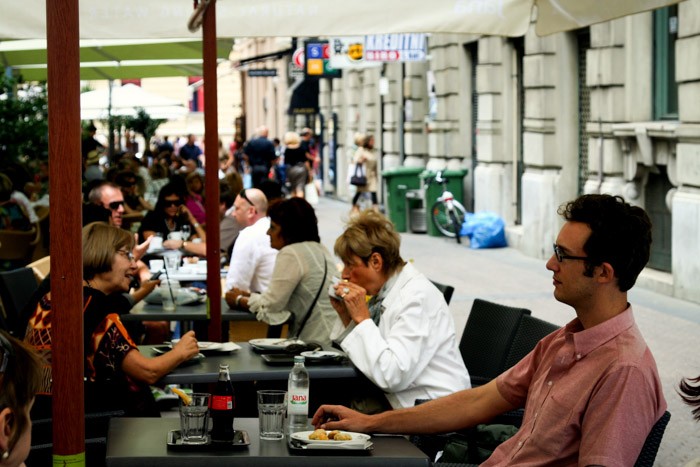
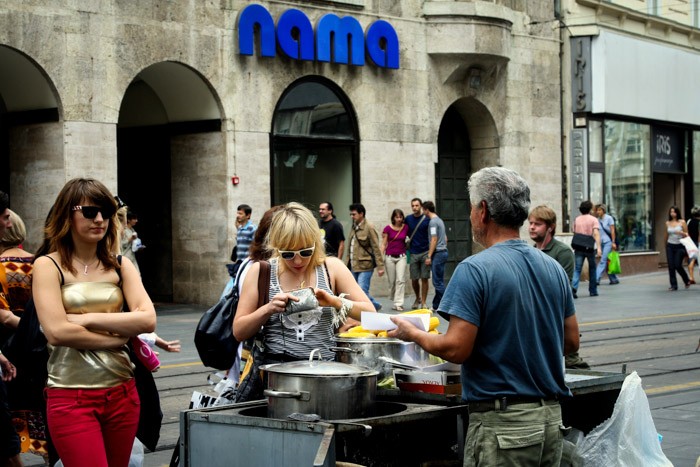
We caught a cab back to the airport, skipping the shuttle connection between the bus station and the airport this time, and spent our last kunas on some Dalmatian fig paste (which we promptly lost aboard the plane) before boarding a flight to Frankfurt. I was amazed at just how much we were able to appreciate Zagreb on such a brief visit. And I was so happy we didn’t spend the day at the airport.
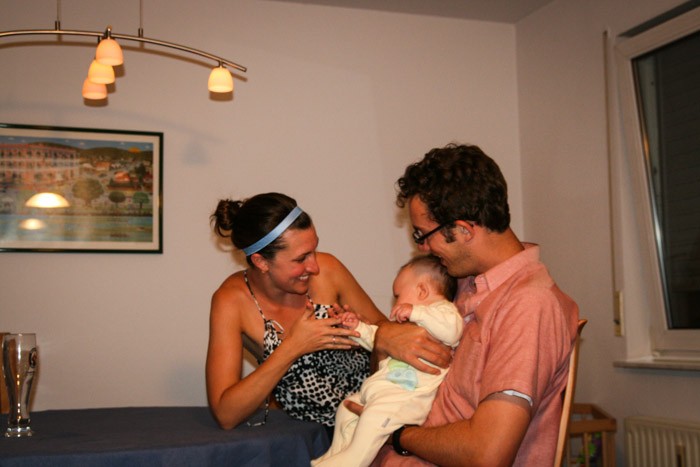
That afternoon we met one of our nephews for the first time and were given a great welcome from his brother and his parents, Laura and Roland. We spent another day and a half with them at their home in Ludwigsburg before flying back to JFK.
Many people have asked us whether we felt that Croatia’s coast could be a cheaper alternative to the French Riviera. Each destination has its own virtues, so I would really hesitate to call one an alternative to the other, but I will at least caution that Croatia wasn’t as inexpensive as we had expected. The big opportunity for savings is lodging. While the hotels can cost you an arm and a leg, sobes are a wonderful resource and are often 35-50 Euro a night. (I say Euro because although the currency is the Kuna, the prices tend to be based on the Euro exchange rate.) The food and drinks along the coast we visited, however, were priced comparably to those in other European vacation destinations.
We had a wonderful visit, a terrific vacation. I hope we’ll have a chance to see more of Croatia—maybe Istria during truffle season?—another time.


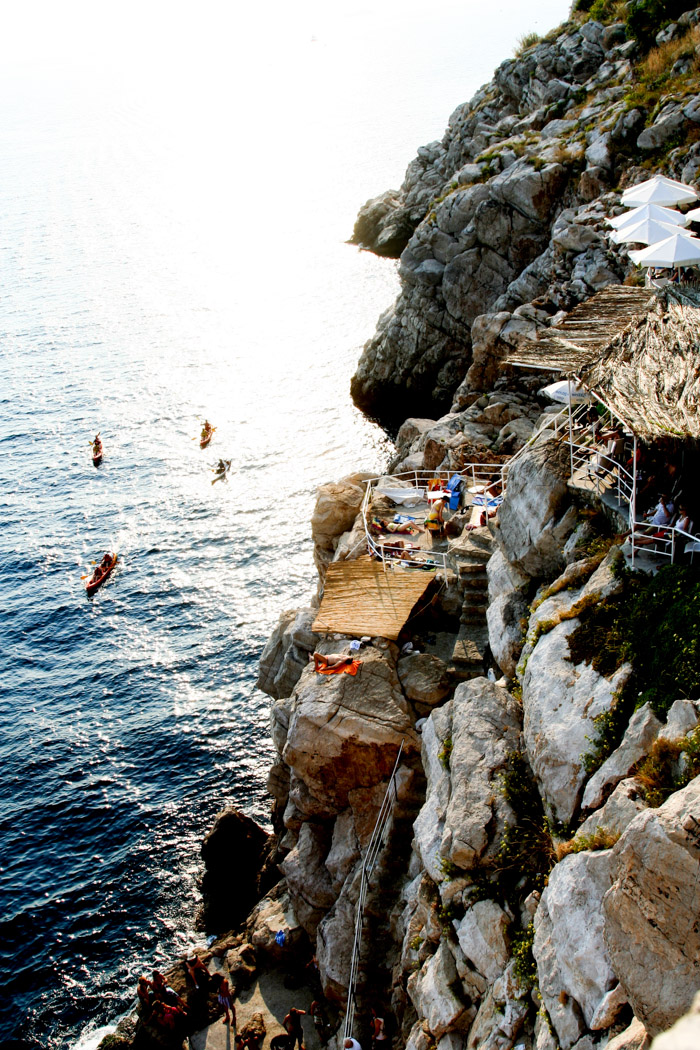
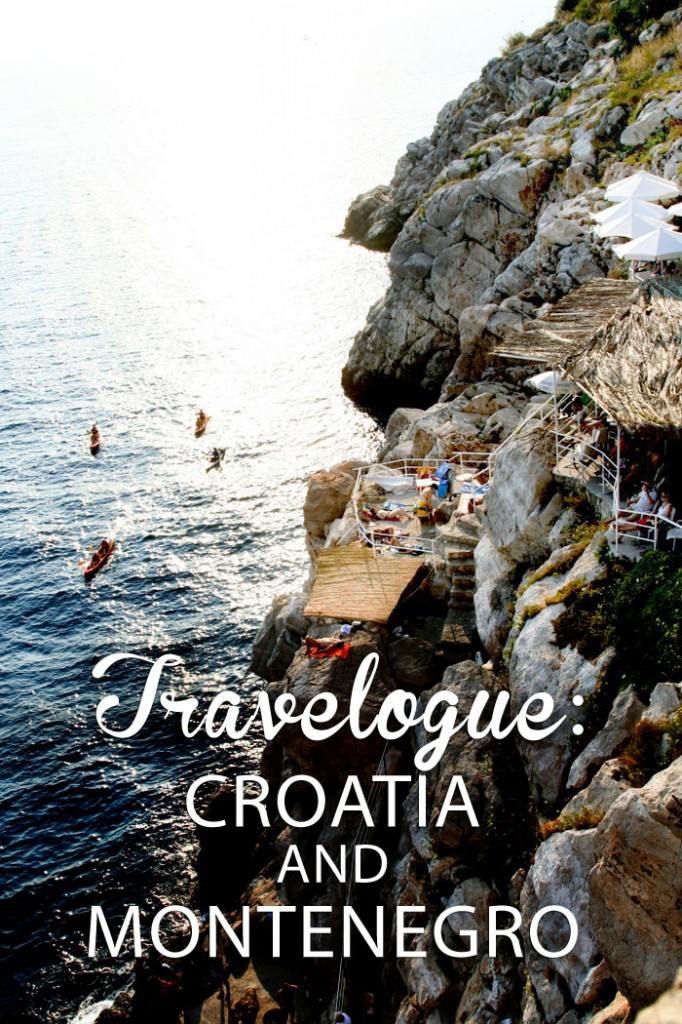
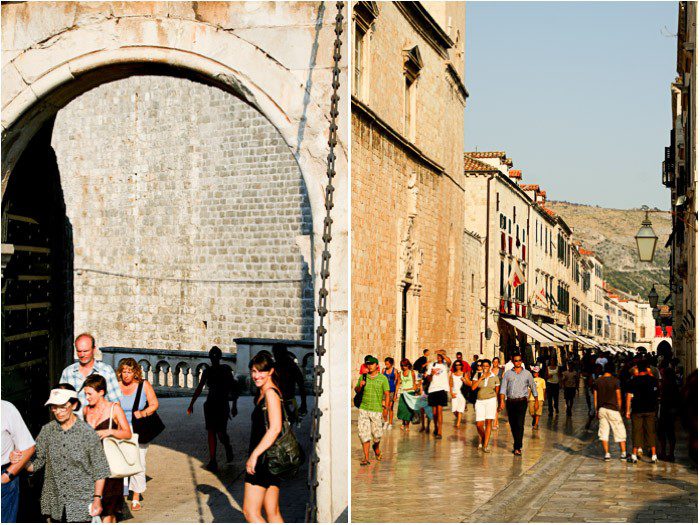























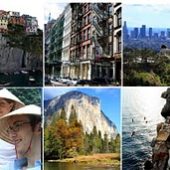
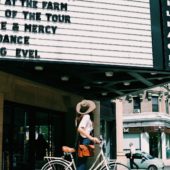
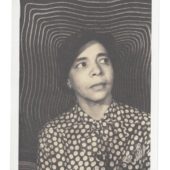
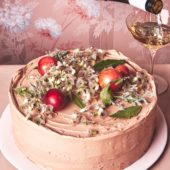











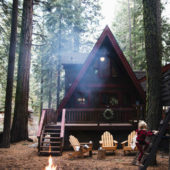



















30 Comments